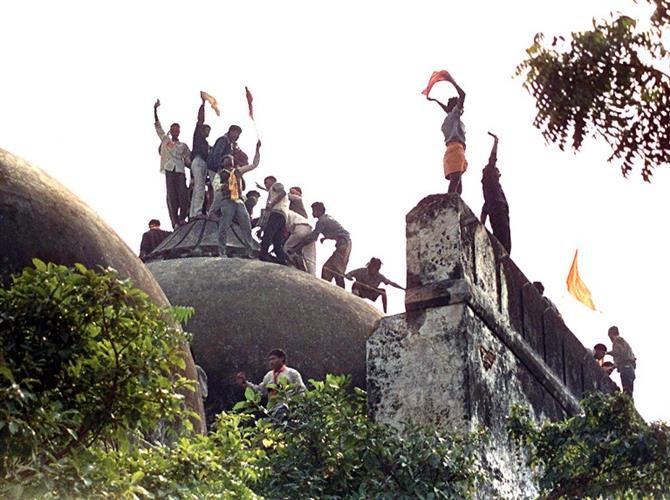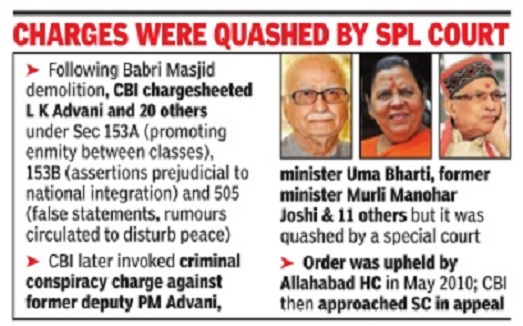Ayodhya (Babri Masjid/ Ram Janambhoomi): the dispute
(→A timeline) |
(→2019/ Babri Demolition Case, ruling) |
||
| Line 791: | Line 791: | ||
=2019/ Babri Demolition Case, ruling= | =2019/ Babri Demolition Case, ruling= | ||
| − | == SC veered towards unanimity after hearings ended== | + | =1= |
| + | =2= | ||
| + | |||
| + | === SC veered towards unanimity after hearings ended=== | ||
[https://epaper.timesgroup.com/Olive/ODN/TimesOfIndia/shared/ShowArticle.aspx?doc=TOIDEL%2F2019%2F11%2F11&entity=Ar00313&sk=5EF9D509&mode=text Dhananjay Mahapatra, Nov 11, 2019: ''The Times of India''] | [https://epaper.timesgroup.com/Olive/ODN/TimesOfIndia/shared/ShowArticle.aspx?doc=TOIDEL%2F2019%2F11%2F11&entity=Ar00313&sk=5EF9D509&mode=text Dhananjay Mahapatra, Nov 11, 2019: ''The Times of India''] | ||
| Line 810: | Line 813: | ||
The first draft of the unanimous judgment was ready late on November 3 and it was circulated among the judges the next day. The judges exchanged their views, suggested additions and deletions as well as alterations in the final draft by Wednesday. And by Thursday, the final judgment was ready for pronouncement. But preparation for writing the judgment was undertaken by each of the five judges right from the day the hearing began on August 6. | The first draft of the unanimous judgment was ready late on November 3 and it was circulated among the judges the next day. The judges exchanged their views, suggested additions and deletions as well as alterations in the final draft by Wednesday. And by Thursday, the final judgment was ready for pronouncement. But preparation for writing the judgment was undertaken by each of the five judges right from the day the hearing began on August 6. | ||
| + | |||
| + | === Evidence reinforced faith-tradition: SC=== | ||
| + | [https://epaper.timesgroup.com/Olive/ODN/TimesOfIndia/shared/ShowArticle.aspx?doc=TOIDEL%2F2019%2F11%2F12&entity=Ar01822&sk=3F103777&mode=text Nov 12, 2019: ''The Times of India''] | ||
| + | |||
| + | The presence of symbols of Hindu religious significance inside and outside the Babri Masjid, which were acknowledged by Muslim witnesses, suggested actual worship took place down the centuries and large congregations visited the disputed site during festivals, the Supreme Court has said. | ||
| + | |||
| + | |||
| + | The SC’s observations in its verdict on the Ayodhya case, bolster the argument that the Hindu community persisted with its claim to worship and the evidences gathered by the Archaeological Survey of India pointed to a religious structure of Hindu origin. | ||
| + | |||
| + | “The oral testimony of Hindu devotees establishes the pattern of worship and prayer at Sita Rasoi, Ramchabutra and towards the ‘garb grih’, while standing at the railing of the structure of the brick wall,” the court has said. The argument that the Ayodhya site’s significance went beyond faith alone, is important even as the court held that the ASI report could not be used to settle a title suit. | ||
| + | |||
| + | The judgement evaluates faith-tradition, ASI evidences, traveller accounts and witnesses to state that the presence of a masjid did not deter Hindus from continuing their worship at the disputed site and within the precincts of the structure prior to the incidents of 1856-57 (when riots broke out over access to the plot). | ||
| + | |||
| + | “The physical structure of an Islamic mosque did not shake the faith and belief of Hindus that Lord Ram was born at the disputed site. On the other hand, learned counsel fairly stated that the evidence relied on by the Sunni Wakf Board to establish the offering of namaz by the Muslim residents commences from around 1856-57,” the SC ruled. | ||
| + | |||
| + | The accounts mentioned by the court have often been part of BJP’s political campaign where the party has argued that the site is of much more significance to the Hindus than a mosque at Ayodhya was to Muslims. Records of travellers indicate, said the court, that there was “historical presence of worshippers and the existence of worship at the disputed site even prior to the annexation of Oudh by the British and the construction of a brick-grill wall in 1857.” The wall was built by the British colonial administration to separate the inner and outer courtyards and restrict access of Hindu devotees. | ||
| + | |||
| + | While the ruling notes that the ASI report does not conclude that remnants of the preexisting structure were used for the purpose of constructing the mosque or there was an act of razing, it notes a reasonable inference can be drawn that foundations of the mosque is based on the walls of a pre-existing structure. This underlying structure was suggestive of Hindu religious origin. | ||
==2020: All accused acquitted== | ==2020: All accused acquitted== | ||
| Line 834: | Line 855: | ||
Former special CBI judge Surendra Kumar Yadav, who gave the verdict in the 1992 Babri demolition case acquitting all 32 accused, including LK Advani, MM Joshi, Uma Bharti and Kalyan Singh, was appointed deputy lokayukta of UP. Yadav had retired as district & sessions judge, Lucknow, in September 2019. The SC had given him an extension to deliver the verdict in the case that he had been hearing since 2015. | Former special CBI judge Surendra Kumar Yadav, who gave the verdict in the 1992 Babri demolition case acquitting all 32 accused, including LK Advani, MM Joshi, Uma Bharti and Kalyan Singh, was appointed deputy lokayukta of UP. Yadav had retired as district & sessions judge, Lucknow, in September 2019. The SC had given him an extension to deliver the verdict in the case that he had been hearing since 2015. | ||
| + | |||
| + | [[Category:Crime|B AYODHYA (BABRI MASJID/ RAM JANAMBHOOMI)AYODHYA (BABRI MASJID/ RAM JANAMBHOOMI)AYODHYA (BABRI MASJID/ RAM JANAMBHOOMI)AYODHYA (BABRI MASJID/ RAM JANAMBHOOMI)AYODHYA (BABRI MASJID/ RAM JANAMBHOOMI)AYODHYA (BABRI MASJID/ RAM JANAM | ||
| + | ]] | ||
| + | [[Category:India|B AYODHYA (BABRI MASJID/ RAM JANAMBHOOMI)AYODHYA (BABRI MASJID/ RAM JANAMBHOOMI)AYODHYA (BABRI MASJID/ RAM JANAMBHOOMI)AYODHYA (BABRI MASJID/ RAM JANAMBHOOMI)AYODHYA (BABRI MASJID/ RAM JANAMBHOOMI)AYODHYA (BABRI MASJID/ RAM JANAM | ||
| + | ]] | ||
| + | [[Category:Pages with broken file links|AYODHYA (BABRI MASJID/ RAM JANAMBHOOMI)AYODHYA (BABRI MASJID/ RAM JANAMBHOOMI)AYODHYA (BABRI MASJID/ RAM JANAMBHOOMI)AYODHYA (BABRI MASJID/ RAM JANAMBHOOMI)AYODHYA (BABRI MASJID/ RAM JANAMBHOOMI)AYODHYA (BABRI MASJID/ RAM JANAMBH | ||
| + | ]] | ||
[[Category:Crime|B AYODHYA (BABRI MASJID/ RAM JANAMBHOOMI)AYODHYA (BABRI MASJID/ RAM JANAMBHOOMI)AYODHYA (BABRI MASJID/ RAM JANAMBHOOMI)AYODHYA (BABRI MASJID/ RAM JANAMBHOOMI)AYODHYA (BABRI MASJID/ RAM JANAMBHOOMI)AYODHYA (BABRI MASJID/ RAM JANAM | [[Category:Crime|B AYODHYA (BABRI MASJID/ RAM JANAMBHOOMI)AYODHYA (BABRI MASJID/ RAM JANAMBHOOMI)AYODHYA (BABRI MASJID/ RAM JANAMBHOOMI)AYODHYA (BABRI MASJID/ RAM JANAMBHOOMI)AYODHYA (BABRI MASJID/ RAM JANAMBHOOMI)AYODHYA (BABRI MASJID/ RAM JANAM | ||
Revision as of 07:53, 19 June 2021
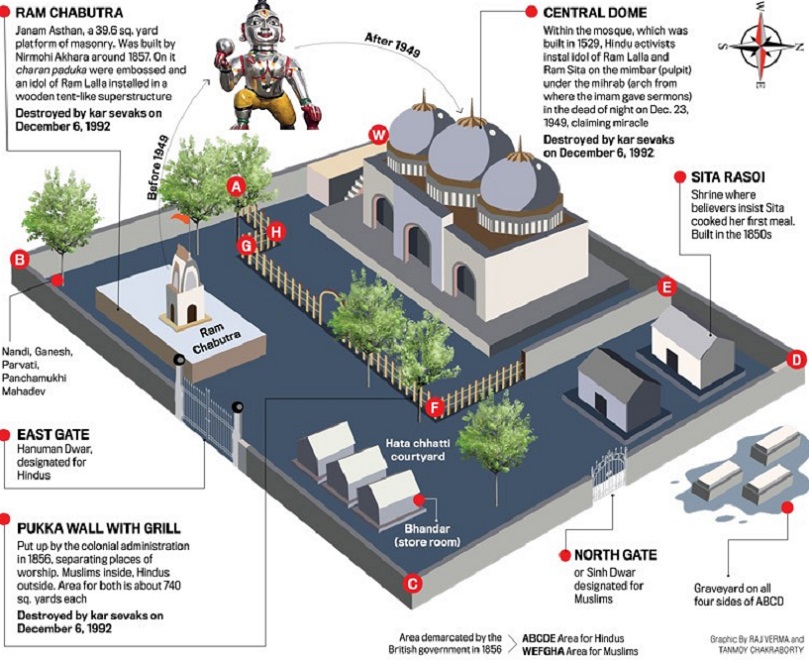
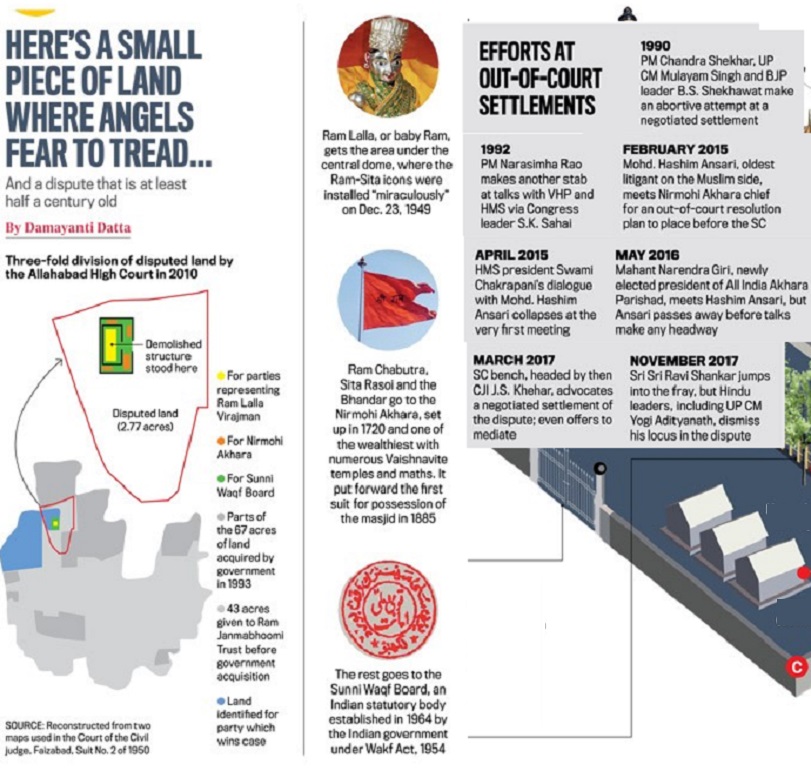
This is a collection of articles archived for the excellence of their content. |
A timeline
The authors of this page are
Babri Masjid demolition: Timeline of events and aftermath | By Mid-day online correspondent | 06-Dec-2016 |Mid-day, which is almost identical to:
Timeline: Ayodhya holy site crisis 6 December 2012 | BBC
Haider Abbas | Babri Masjid: The story of crime # 197/1992| The Milli Gazette 16-30 June 2012
With additional inputs from Q&A: The Ayodhya dispute |5 December 2012| BBC
The Janam Sakhis of Guru Nanak Dev
Abhinav Garg, Nov 11, 2019: The Times of India
The SC verdict that settled the Ayodhya dispute has a historical nugget tucked away in its 1,045 pages that many might not have known about — the Sikh connection in what has been seen as a Hindu-Muslim tussle.
An evidence that helped strengthen the Hindu side’s claim to the disputed site was the visit by Guru Nanak Dev to Ayodhya for Ram Janmabhoomi darshan in 1510-11 AD. Babri Masjiddid not come up until after the 1526 Battle of Panipat.
More than three centuries later, in 1857, a Nihang Sikh barged inside the mosque and occupied it for a considerable amount of time, even setting up a platform on which an idol of Lord Ram was placed. With a posse of 25 Sikhs standing guard outside, the Nihang Sikh lit a fire and started arrangements for puja, leading to the first recorded instance of friction between Hindus and Muslims over the structure. The Nihang Sikh scrawled “Ram” on the walls of the mosque, according to police complaint.
The addenda to verdict bring on record the Janam Sakhis, or writings that profess to be biographies of Guru Nanak Dev. On the question of “whether the disputed structure is the birthplace of Lord Ram according to belief of Hindu devotees”, the SC says there is no material to identify the exact place of Ram Janmabhoomi. But it recognises the visit of Guru Nanak Dev to Ayodhya as an event depicting visits by pilgrims even before 1528 AD.
The judgment says, “It is found that in period prior to 1528 AD, there were sufficient religious texts, which led Hindus to believe the present site of Ram Janmabhoomi as birthplace of Lord Ram.”
One of the witnesses in suit number 4, during his examination in Allahabad HC, had referred to books on Sikh cult and history. He said Guru Nanak Dev had sought darshan at the Shri Ram Janmabhoomi temple. To his statement, he appended various Janam Sakhis documenting the visit of Guru Nanak Dev to Ayodhya.
The verdict also traces a second event that occurred against the backdrop of 1857 transfer of power, when complaints sent to the Oudh administration (as Ayodhya and nearby areas were then referred to) reported the presence of Sikhs. A complaint in 1860 to deputy commissioner of Oudh said local Muslims were facing problems in performing namaz at the mosque. “The Azaan of Moazzin was met with the blowing of conch shells by Hindus. A contentious situation was arising. The Nihang Sikh was evicted from the site and a record was maintained,” SC notes, deducing that it showed namaz was at that stage being performed in the mosque.
That incident led to the installation of a railing in the form of a grill-brick wall outside the mosque. It was also the genesis of division of the complex into an inner courtyard (in which stood the structure of the mosque) and outer courtyard. “The construction of a railing in 1856-7 to provide a measure of separation between the inner and outer courtyards led to the construction of a platform by Hindus in close proximity to railing in outer courtyard. The platform, called Ramchabutra, became a place of worship for Hindus,” states the verdict.
History: 1527- 1992
1527-1885
The Indian city of Ayodhya, in the northern state of Uttar Pradesh, is located 550 km east of New Delhi. The name Ayodhya means, “Not to be warred against,” [Or ‘The land without war’] (Reality Views)
The destruction of the 16th-century mosque in the town of Ayodhya, Uttar Pradesh was a break-point in the Hindu-Muslim fabric of the nation. While some say that the site where the mosque stood is the birthplace of Lord Ram, the issue has been raging from eons. Here is a timeline of how communalism threw modern India into jeopardy.
1527 or 1528: A mosque is built on the site which some Hindus say marks the spot where Lord Ram was born. Some have claimed an old Hindu temple was demolished and a mosque constructed at the same place in Ayodhya and named after Babur and hence the name Babri Masjid.
According to Reality Views The date of the construction of the Babri Mosque is disputed. Before the 1940s, the Mosque was called "Masjid-i Janmasthan".
1853: First recorded incidents of communal clashes at the site.
1859: British colonial administration erected a fence to separate the places of worship, allowing the inner court to be used by Muslims and the outer court by Hindus. This stood for 90 years.
1855: Hindus and Muslims clash over possession of the mosque. There are claims that Sita Rasoi and Ram Chabootara were built around this time (Reality Views)
1885: Mahant Raghubar Das files a suit seeking permission to build a canopy on Ram Chabootra (Reality Views)
The legal case: 1885- 2017
The juggernaut of litigation for ownership over 2.77 acres of Ayodhya land, where the Babri Masjid-Ram Janmabhoomi disputed structure stood since 1528 till its demolition on December 6, 1992, is about to start rolling towards final destination in the Supreme Court.
But the question that stares the two communities — Hindus and Muslims — is whether the final adjudication on the title suits by the highest court of the land be able to bury the ‘more than century’ old dispute and bring peace between the communities? History has witnessed large-scale rioting and loss of lives because of polarisation over the issue in the last three decades.
Advocate Virag Gupta has published a compendium on Ayodhya case in courts giving insight to the birth of a small stream of litigation on Ayodhya land and how it grew into a big river over nearly two centuries. The strong undercurrents against the mosque was felt by the British in the 1850s and they fenced the structure in 1859.
In 1885, a suit seeking permission for constructing a Ram Temple at the disputed site was filed by Mahant Raghubar Das. The trial court rejected it fearing such permission could lead to riots. Appeals too were rejected. In 1934, a mob damaged parts of the disputed structure. The British repaired it. Muslims continued to offer prayer and Hindus worshipped at Ram-Chabutra and Kaushalya Rasoi.
On the intervening night of December 22-23, 1949, idol of Lord Ram was surreptitiously placed under the central dome of the disputed structure. Worship by devotees started in a big way from next morning. District authorities, fearing riots, sealed the premises immediately.
In 1950, two civil suits were filed — one by G S Visharad of Hindu Mahasabha claiming right to worship and second by Paramhans Ramachandra Das seeking to restrain administration from removing the idols. The trial court allowed worship and restrained the district authorities from removing the idols. The Allahabad high court confirmed the trial court’s interim orders in 1955.
In 1959, Nirmohi Akhara filed the third suit seeking right to worship idols under
the central dome and handing over of management of the disputed structure to a Hindu Mahant. Sunni Central Wakf Board filed the fourth suit in 1961 seeking removal of idols and possession of the disputed structure, but withdrew it in 1964. It was added as a defendant in the suit filed by Paramhans Ramchandra Das in 1989.
The White Paper on Ayodhya brought out by the Congress government led by P V Narasimha Rao in February 1993 said: “The Hindu idols thus continued inside the disputed structure since 1949. Worship of these idols by Hindus also continued without interruption since 1949 and the structure was not used by the Muslims for offering prayers since then.”
Another important turn to the roller-coaster journey of Ayodhya dispute took place in 1986, when the Faizabad district court ordered opening of the lock placed on the iron grill gate leading to the central dome of the disputed structure. Many believe the gates were opened at the behest of central government headed by Rajiv Gandhi.
Babri Masjid Action Committee (BMAC) was formed and it launched protest movement seeking restoration of disputed structure to Muslims while Vishwa Hindu Parishad (VHP) spearheaded the Hindu organisations and mobilised public for construction of a Ram temple at the disputed site. The title suits pending in Faizabad district court were transferred to Lucknow bench of Allahabad HC in 1989.
After December 6, 1992 demolition of Babri Masjid, the Ayodhya case got split into two — one, the title suits pending in Allahabad HC’s Lucknow bench and second, the criminal cases filed against top BJP leaders including L K Advani and Murli Manohar Joshi for exhorting the Kar Sevaks to raze down the disputed structure. The central government acquired the disputed structure and land surrounding it through a law in January 1993.
The Allahabad high court (Lucknow) bench of Justices S U Khan, Sudhir Agarwal and D V Sharma had considered archaeological evidence, which conclusively indicated that Babri Masjid was built on the ruins of an ancient Hindu temple. The HC divided the Ayodhya land equally between three parties — Ram Lalla (idol), Nirmohi Akhara and Sunni Wakf Board.
The criminal case against BJP leaders too has entered its final phases with the Supreme Court on April 19, 2017 asking the trial court to proceed with the trial, which had been stalled for a long time, and conclude it within two years. That means, the trial court, if it does not seek extension of the two-year time period, would pronounce its verdict before April 19 this year.
While striking down acquisition of 2.77 acres of disputed Ayodhya land, on which the structure before demolition stood, and surrounding 67.703 acres of land, the SC in Ismail Faruqui case [1994 (6) SCC 360] had asked the Centre to act as Receiver of the two tracts of acquired land till final judgement on the title suits.
In the 1994 judgment, it had said:“We have no doubt that the moderate Hindu has little taste for the tearing down of the place of worship of another to replace it with a temple. It is our fervent hope that the moderate opinion shall find general expression and that communal brotherhood shall bring to the dispute at Ayodhya an amicable solution long before the courts resolve it.”
“Ayodhya is a storm that will pass”, the Supreme Court had hoped. It had been proved wrong. An amicable solution eludes the vexed issue. BMAC-VHP negotiations had reached a critical stage in the late 1980s before breaking down. Two years ago, then CJI J S Khehar had surprised many by offering to be the facilitator for a dialogue between the leaders of the two communities warring over the disputed land. But, little came out of it. The storm continues to threaten the communal harmony. It is doubtful whether the final judgment from the highest court would be able to tame the storm.
1949-1991
Dec 1949: Idols of Lord Ram appear inside mosque, allegedly placed there by Hindus. Hindu wing is also said to have allegedly said that the idols had miraculously appeared. Muslims protest resulting in both the parties filing civil suits. The government then declared the premises a disputed area and locked the gates. Police lodge FIR; city magistrate attaches mosque property and locks it The Times of India | 6 Dec 2017
BBC adds: Muslims say they offered prayers at the mosque until December 1949, when some people placed the idols of Ram under the cover of darkness in the mosque. The worship of the idols began soon after. (End of BBC item)
Jan 1950: Gopal Singh Visharad and Mahant Paramhand Ramchandra Das file civil suits in Faizabad, asking for unlocking of Masjid premises and permission to offer prayers to the idols installed at Asthan Janmabhoomi. Inner courtyard gates are locked, but puja is allowed. (Reality Views) Ramchandra Das Paramahans, Mahant of Digambar Akhara, and Nirmohi Akhara later approach court with same demand The Times of India | 6 Dec 2017
1959: Nirmohi Akhara and Mahant Raghunath file a case, claiming to be the sect responsible for conducting puja (Reality Views)
Feb 1961: Sunni Central Waqf Board.UP, challenges the 3 suits filed by Hindu side, declaring Babri Masjid property of the board. Hashim Ansari and 5 others join. Sunni Central Board of Waqfs, UP, claims the mosque and the surrounding land was a graveyard (Reality Views) The Times of India | 6 Dec 2017
1984: Hindus form a committee to "liberate" the birth-place of Lord Ram and build a temple in his honour. The movement was spearheaded by Vishwa Hindu Parishad (VHP) to build a temple at the site, which they claimed was the birthplace of Lord Ram. It gathered momentum when they formed a committee to construct a temple at the Ramjanmabhoomi site. Then Bharatiya Janata Party (BJP) leader Lal Krishna Advani, took over leadership of campaign.
Feb 1986: Faizabad district judge Hari Shankar Pandey orders unlocking of gates of Babri Mosque after almost five decades in favour of Hindu parties and allowed Hindus to worship inside the 'disputed structure.' The gates were opened in less than an hour after the court decision. Muslims set up Babri Mosque Action Committee in protest against the move to allow Hindu prayers at the site. The Times of India | 6 Dec 2017
1989: VHP steps up the campaign and proclaims that a Shilâ or a stone will be established for construction of temple near the area. In November, the Vishwa Hindu Parishad laid foundations of a temple on land adjacent to the 'disputed structure'. (Reality Views) adds: Former VHP vice-president Justice Deoki Nandan Agarwal files a case, seeking the mosque be shifted elsewhere
1989 All cases of title suit go to HC. Triloki Nath Pandey becomes party, claiming himself as ‘best friend’ of Ram Lalla The Times of India | 6 Dec 2017
1990: VHP volunteers partially damage the mosque. The then Prime Minister Chandra Shekhar tries to resolve the dispute through negotiations, which fail in 1991.
1991: BJP comes to power in Uttar Pradesh state, where Ayodhya is located. The power at the Centre, is however Congress.
A timeline of the case: Till Oct 2019
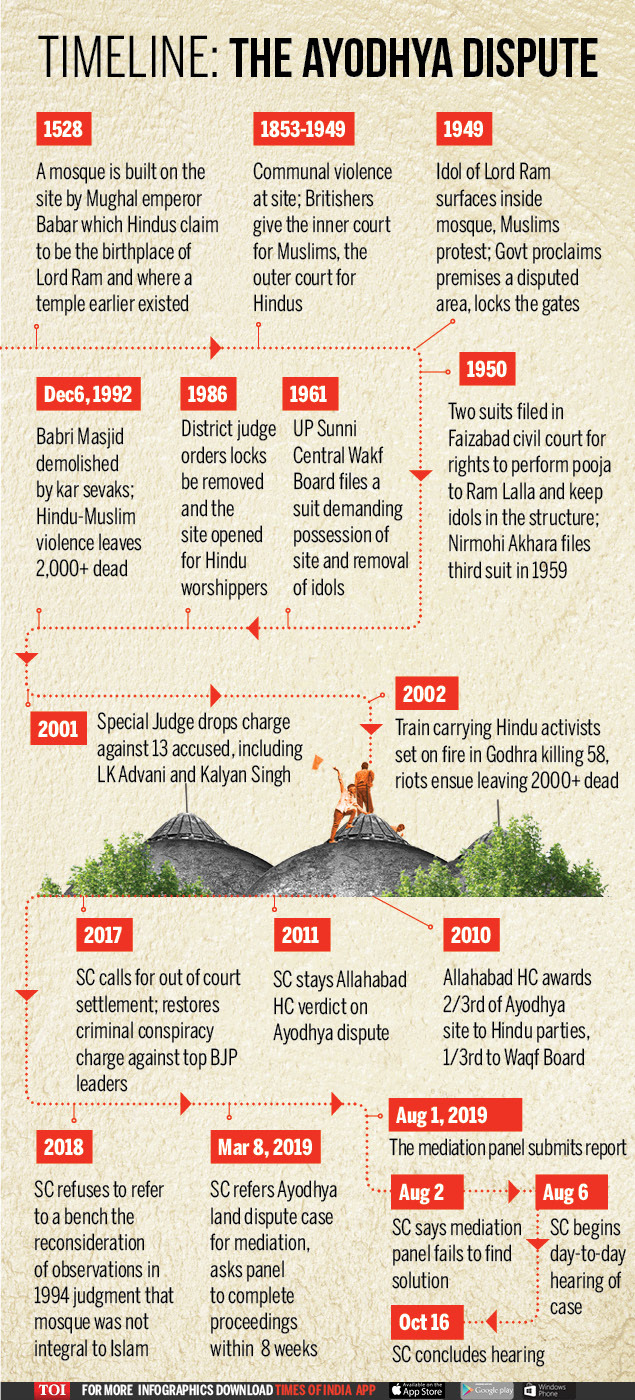
From: July 31, 2020: The Times of India
See graphic:
A timeline of the Babri Masjid/ Ram Janambhoomi case: Till Oct 2019
1992
Rao, PM, wanted mosque, temple to stand together
Lucknow:
Before the demolition of Babri Masjid, the then PM Narasimha Rao had asked the Gujarat-based chief architect of the Ram temple project Chandrakantbhai Sompura whether the mosque, too, could be part of the plan and whether the Babri Masjid and a Ram temple could stand next to one another, reports Yusra Husain.
According to Sompura (77), Rao, in seeking his opinion, had been hinting that the mosque could remain where it was and the temple could be constructed from beyond the Ram Chabutra. But the idea could not be realised as Vishwa Hindu Parishad (VHP) opposed it.
“The PM called me up and asked if the mosque, with its three iconic domes, could be part of the design along with the temple. I communicated the idea to VHP, who had roped me in for the project, but it opposed it and the idea got buried in time,” Sompura told TOI over the phone from Ahmedabad.
“VHP was adamant if the 6-foot-by-3-foot space of the khatiya (bed) where Bhagwan Ram was born is not the centre of the Ram mandir, it wouldn’t matter where the temple came up. The Ram mandir had to be built at the very spot where the structure (mosque) was as they believed Lord Ram was born in the area right under the central dome,” he added.
1992 onwards/the events
1992: Demolition of the Babri Masjid
The mosque is razed down by more than lakh supporters of the VHP, the Shiv Sena party and the BJP, prompting nationwide riots between Hindus and Muslims in which more than 2,000 people die. India Today adds:
India Today December 29, 2008
On December 6, 1992, an unprecedented religious frenzy whipped up by an array of Hindu rightwing organisations brought down the medieval Babri Masjid, while the state, represented by 25,000 paramilitary personnel, including the elite NSG, stood like spectators. It was a monumental failure of both the intelligence and security establishments. The widespread riots that followed the demolition rent the nation’s social fabric. “The damage to India’s polity and the reputation of the law enforcers was irreparable,” wrote India Today in December 1992.
End of India Today item
The events of 6 Dec 1992
Avijit Ghosh, December 6, 2017: The Times of India
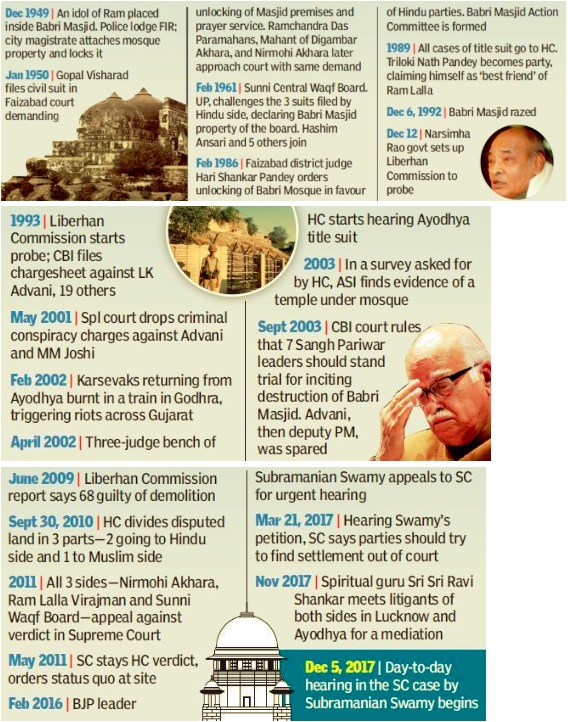
From: Avijit Ghosh, December 6, 2017: The Times of India
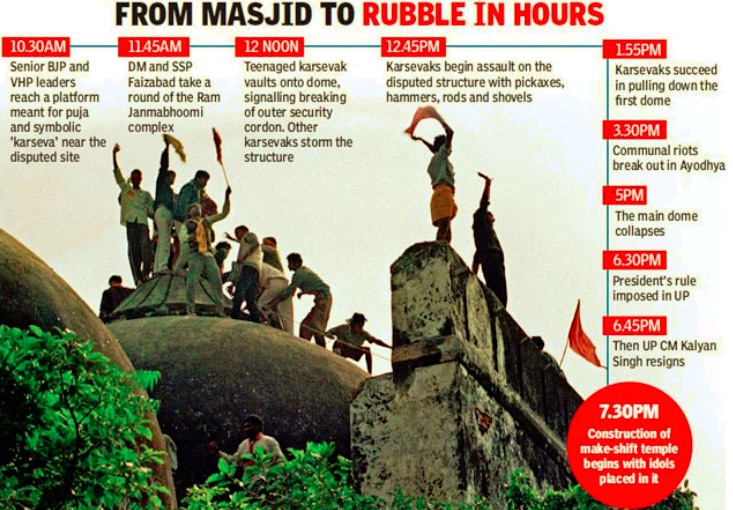
From: Avijit Ghosh, December 6, 2017: The Times of India
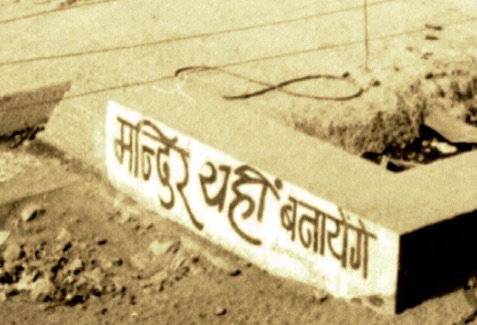
From: Avijit Ghosh, December 6, 2017: The Times of India
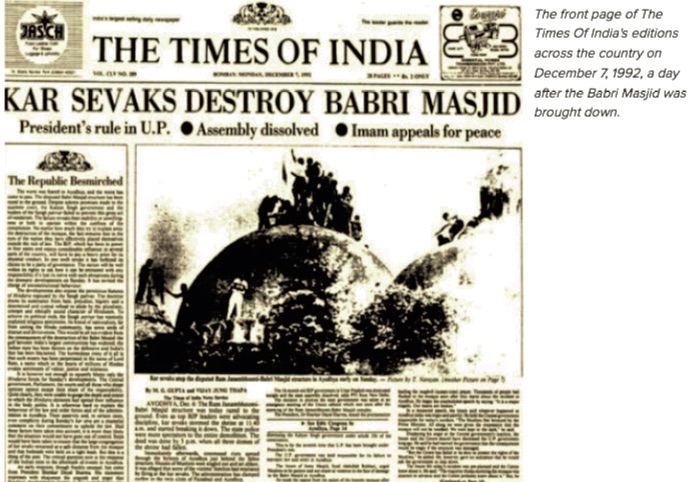
From: Avijit Ghosh, December 6, 2017: The Times of India
HIGHLIGHTS
When hordes of karsevaks brought down the 16th century structure hoping to build a Ram Mandir in its place, many Indians also felt the same way wondering if the nature of national politics had altered forever. The masjid's razing was the final outcome of the Ram Janambhoomi movement which had gathered steam since 1990.
In Naseem, director Saeed Mirza's tender yet unsettling movie on the days leading to the Babri Masjid's demolition, a bedridden old man lives in a mansion of memory reciting Urdu couplets and cocooning himself from the turmoil. He dies the day the mosque is brought down. Mirza once said, the film "was an epitaph to the dream that India gave itself at the time of Independence."
When hordes of karsevaks shouted, "Ek dhakka aur do, Babri Masjid tod do," and brought down the 16th century structure hoping to build a Ram Mandir in its place, many Indians also felt the same way wondering if the nature of national politics had altered forever. The masjid's razing was the final outcome of the Ram Janambhoomi movement which had gathered steam since 1990. The movement was piloted by the Sangh parivar with top BJP and VHP leaders at its forefront.
The political ramifications
Avijit Ghosh, December 6, 2017: The Times of India
Twenty-five years on, the jury is still divided on the long-term impact of the controversial issue. Some believe it was a game-changing moment, others differ. BJP politician Chandan Mitra says that the masjid's demolition marked "a decisive turn" in the nature of Indian politics whereby the idea of "cultural nationalism" overtook the existing "ideological nationalism" that India saw since Independence.
Till then, he says, identity politics was confined to caste and small groups. "This was a supra identity that sought to be established as a kind of majority nationalism. The idea has been gaining ground since then and has established itself as the dominant theme in Indian politics," he says.
Political scientist Imtiaz Ahmed provides a counter. He says the demolition is "a peripheral issue" in Indian politics today, raised sporadically "to influence the electoral process." Even the electoral relevance of Babri Masjid or building the Ram Mandir has declined, he says.
"The BJP recognises this. It is not interested in building the temple but in keeping the issue alive. BJP occasionally talks about it only to use it to polarise the votes and gain some advantage. Look how the Babri Masjid issue is irrelevant in the forthcoming Gujarat election. Even in the UP state election this year, it was not an issue," says Ahmed.
A BJP-led Union government ruled between 1999 and 2004. The saffron party enjoys a majority in the Lok Sabha since 2014. But the issue, as Ahmed says, has never been on the front-burner. Mitra points out that building the temple is "very much" a part of BJP's agenda. However, he says that the Supreme Court order, which says that there can be no construction at the site, has "taken the sting out of the movement." "It will be difficult to violate SC's order unless the two communities are in agreement. That too does not seem likely," he says.
Dalit commentator Chandrabhan Prasad too feels the impact of the masjid's demolition has been limited. "In UP, we've seen BSP and SP roar to power with absolute majority. If the politics had changed permanently, this wouldn't have happened," he says.
Prasad believes that liberalisation had a far greater impact on long-term national politics than the flattening of Babri Masjid. "Dalits have been the biggest beneficiaries of the Constitution and the market economy," he says.
Social scientist and politician Yogendra Yadav provides the big picture saying that the demolition signals a shift in popular opinion. "The middle ground of public opinion decisively shifted towards majoritarianism thereafter. It taught us that secularism cannot be defended merely with instruments of law or arms of the state. We realised that when public opinion shifts, everything else - politics, state institutions, even judiciary, shifts," he says.
"Therefore, the real lesson is that the battle to save secularism has to be fought in the minds of ordinary people. That sadly is a battle secular Indians have not seriously engaged with. This would mean a deeper engagement with our traditions, in Indian languages, and with the common sense of ordinary people. The longer we delay it, the weaker our republic becomes, and susceptible to the kind of thuggery we see today," Yadav says.
Rao govt could have saved Babri: the then Home Secy
Nov 4, 2019: The Times of India
The Babri Masjid could have been saved if there was political will to act and the then PM P V Narasimha Rao did not accept a comprehensive contingency plan of the home ministry prepared before the demolition, claims Madhav Godbole who was the Union home secretary that time.
“If political initiative had been taken at the prime minister’s level, the Mahabharata of this Ramayana could have been avoided,” he says in his new book on the Ayodhya dispute.
Seeking to draw a cogent picture of the events which transpired during the critical period before and after the demolition, Godbole says as PM, Rao “played the most important role in this crucial test match, but, unfortunately, he turned out to be a non-playing captain”.
In “The Babri Masjid-Ram Mandir Dilemma: An Acid Test for India’s Constitution”, the author claims that besides Rao, former prime ministers Rajiv Gandhi and V P Singh also failed to take timely action when the mosque was under serious threat.
In 1992, after detailed discussions with institutions and officers concerned, Godbole says the MHA prepared a comprehensive contingency plan for the takeover of the structure by invoking Article 356 of the Constitution. The Ministry of Law had also cleared the Cabinet note for this purpose, he adds.“For this purpose, it was underlined that action would have to be taken well before the proposed date of commencement of ‘kar seva’...” he writes in the book.
But Rao felt the contingency plan was not workable and dismissed it, he says. PTI
Hindu neighbours ensured food in area under curfew
It was the evening of December 6, 1992. The Babri Masjid had been brought down to a rubble. Mohan Yadav and Sohan Singh were in an animated discussion in Kanpur’s Barra area when they saw about 300 Muslims fleeing, trying to take refuge in the Hari Masjid (mosque painted green) in the area.
“They were carrying lists in hand and knew where Muslim families in the southern part of Kanpur lived. They were hunting the Muslims down. They were carrying weapons and had come prepared,” said Mohan, now in his 60s.
Since the evening of December 6, 1992, and the next few days, Kanpur burnt in the aftermath of the Babri Masjid demolition. Exactly 25 years later, residents — both Hindus and Muslims — those affected by the days of rioting, of sleepless, harrowing nights rife with rumours and true incidents, recall gory details of the tragic month.
Barra-II witnessed the worst carnage. Yadav and Singh, while recalling the “bhayanak” day, remember how they, along with a few others – Mangali Verma and Rajeev Yadav – helped save some of them, though the administration had asked people not to venture close to the riot-hit areas.
“All our lives, we have had tea together over addas. They were like our brothers. How could we have kept away when they were in danger?” said Sohan Singh.
“Even as we encircled the open truck to let Muslims be taken first to Sachendi and then to the refugee camp at Green Park stadium, some police officers asked us to let the truck full of people be pushed into the Pandu river,” added Sohan.
“It started when Bharat Tailors was looted and burnt. Rioters came to Barra. Stuck inside the Hari Masjid, we could hear slogans and sounds of firing. This continued till December 10,” said Mohammad Suleman Jilani, mutawwali (caretaker) of the Hari Masjid.
Jilani said while officers at Govind Nagar police station did not act, Barra police station in-charge Prem Babu Sharma and outpost in-charge Jai Narayan Tiwari, were saving people’s lives. “In Damodar Nagar, a house was set on fire with 13 people inside it when Jai Narayan Tiwari helped them get out through the back door with the help of a rope, even as his own motorbike was burnt," said Jilani.
It was also because of the few Hindus of Barra area that another mosque in Nayi Basti area was saved from rioters, recalled Jilani's family. “When the area was under curfew, these men would under their protection, take a subzi-wallah to the area, so that food be made available to Muslim families under siege,” they said.
1992-1997: the events
1992, Dec 12 Narsimha Rao govt sets up Liberhan Commission to probe 1993 Liberhan Commission starts probe; CBI files chargesheet against LK Advani, 19 others HC starts hearing Ayodhya title suit The Times of India | 6 Dec 2017
2003 In a survey asked for by HC, ASI finds evidence of a temple under mosque May 2001 Spl court drops criminal conspiracy charges against Advani and MM Joshi The Times of India | 6 Dec 2017
Feb 2002 Karsevaks returning from Ayodhya burnt in a train in Godhra, triggering riots across Gujarat The Times of India | 6 Dec 2017
April 2002 Three-judge bench of Sept 2003 CBI court rules that 7 Sangh Pariwar leaders should stand trial for inciting destruction of Babri Masjid. Advani, then deputy PM, was spared June 2009 Liberhan Commission Subramanian Swamy appeals to SC report says 68 guilty of demolition for urgent hearing The Times of India | 6 Dec 2017
1992 onwards/ The legal case
Crime No. 197/1992
Haider Abbas | Babri Masjid: The story of crime # 197/1992| The Milli Gazette 16-30 June 2012 adds:
The Babri Masjid demolition case stems from two cases: Crime No. 197/1992 and Crime No 198/1992.
To begin with, on the day of demolition of Babri Masjid, on Dec 6, 1992, a First Information Report (FIR)-197/1992 was lodged at 5:15 pm by Privambada Nath Shukla (50 years), Station Officer at Police Station (PS), Ramjanum Bhumi, Ayodhya, against lakhs of Karsevaks - names and addresses unknown - Under Section (U/S) 395 (dacoity), 397(dacoity or robbery with attempt to cause death), 332 (causing hurt to deter public servants), 337, 338 (grievous hurt), 295 (injuring or defiling a place of worship with intent to insult religion of any class, 297 (trespass in any place of worship) and 153-A of Indian Penal Code (IPC), which makes promoting enmity between different groups inter alia of religion, read with Section 7 Criminal Law Amendment Act. This eventually led to 49 FIRs being filed against 49 persons with respect to cognizable offences and one FIR relating to non-cognizable offence committed against mediapersons who were recording the demolition of the Babri Masjid and whose video cameras etc were snatched and broken/robbed by the Karsevaks.
On Dec 13, 1992, this case was entrusted for investigation to the Central Bureau of Investigation (CBI). Later Crime No. 198/1992 also was assigned to the CBI for investigation. Both cases were obviously related, hence they were bunched together.
On Sept 8, 1993, the UP government, in consultation with the High Court, created a Special Court at Lucknow (also known as CBI Court), and on 9 Sept 1993, in consultation with HC, the state government referred Crime No. 197/1992 and 47 other cases to the Special Court headed by Additional Chief Judicial Magistrate (ACJM Ayodhya Prakaran) at Lucknow.
Now, since both the cases were under the ambit of CBI, hence it filed a consolidated charge-sheet in Crime No. 198/1992, as well as against thirty-two others accused in Crime No. 197/1992 and in 47 other related cases.
By Aug 27, 1994, all the cases referred to above were committed by ACJM, Lucknow to the Lucknow Sessions Court. CBI also filed a supplementary charge-sheet on Jan 11, 1996, in which it accused another nine persons who were later committed from ACJM, Lucknow to Lucknow Sessions Court on April 10, 1996. These nine persons were a part of the overall 49 accused. All this continued for yet another year and a half, until on Sep 9, 1997 ACJM Ayodhya Prakaran (Session Court), Lucknow charged the accused U/S 147, 153-A, 153-B, 295, 295-A, 505 read with 120-B (conspiracy) IPC. For the first time, in the history of the case, the conspiracy charge was levelled.
This order was challenged by the 33 accused at the Lucknow bench of Allahabad HC through Criminal Revision No. 199/1997 (Moreshwar Save vs. State of UP, 201/97 (Uma Bharti alias Gajra Singh vs. State of UP, 211/97 (RN Srivastata vs State of UP) and 255/97 (Ashok Singhal vs. State of UP) which led to Justice Jagdish Bhalla at the Lucknow bench of Allahabad High court say that the reference of Crime No. 198/1992 was not done in consultation with the HC, hence, the Session Court was not in a position to try the accused. This order, which came on Feb 12, 2001, derailed the entire prosecution process..
The fallout of Justice Bhalla’s : as on May 4, 2001, the CBI Court, Lucknow ordered the proceedings to be dropped against 25 accused including the eight accused in the Crime No. 198/1992 alongwith 13 of Crime No. 197/1992, on the pretext that these persons were covered by Crime No. 198/1992 in respect whereof the CBI court has no jurisdiction.
CBI chose to rise against the order and filed a Criminal Revision 217/2001 CBI vs. Balasahab Thackaray in June 2001. It seven years to reach to a point when the same Criminal Revision was decided and finally on May 20, 2009, Justice Ashok Kumar Singh found it fit to be dismissed. Against the same order CBI has gone to the Supreme Court (SC).
Crime No 198/1992
Haider Abbas | Babri Masjid: The story of crime # 197/1992| The Milli Gazette 1-15 July 2012
Crime No. 198/1992 pertains to high-ranking persons
The second First Information Report (FIR) was lodged on Dec 6, 1992, by Ganga Prasad Tiwari-U/S 153-A, 153-B (imputations prejudicial to national integration) and 505 (statements conducing to public mischief). This case was filed against eight hig BJP/VHP leaders: S/ Shri LK Advani, MM Joshi, Vinay Katiyar, Uma Bharti, Ashok Singhal, Giriraj Kishor, Sadhvi Rithambra and Vishnu Hari Dalmia. The above sections of the Indian Penal Code are cited by police when communal speeches are delivered. The FIR was in context to the speeches delivered in the morning of Dec 6 prior to the demolition.
It took just four days for the state government, on Dec 10, 1992, to entrust the crime for investigation to Crime-Bureau Chief Investigation Department, UP (CB-CID). Six days later, on Dec 16, 1992, the state government, in consultation with the High Court, Lucknow, set up a Special Court of Judicial Magistrate at Lalitpur, UP. On Feb 27, 1993, the charge-sheet was filed U/S 153-A, 153-B, 505, 147 (punishment for rioting), 149 (membership of unlawful assembly, guilty of offence committed in prosecution of common object) of IPC. This charge-sheet was later enhanced by CB-CID at Lalitpur, UP. On March 1, 1993 the Magistrate at Lalitpur, UP took cognizance of the same. Later, on July 8, 1993, the same case was shifted to Rae Bareli, UP.
This was followed by state government requesting the central government, on Aug 25, 1993 to refer Crime No. 198/1992 to the Central Bureau of Investigation (CBI). Finally, the case was handed over to CBI, on Aug 26, 1993. The next move came in the form of state government, in consultation of the HC, creating a Special Court at Lucknow on Sept 8, 1993. On the next day, Sept 9, 1993, in consultation with HC, the state government referred Crime No. 197/1992 as well as 47 other related cases (which stemmed from the same event) to the Special Court headed by the Additional Chief Judicial Magistrate (ACJM Ayodhya Prakaran) at Lucknow, UP. This was also called as “CBI Court”.
Next month, on Oct 5, 1993, the CBI filed a consolidated charge-sheet against all the eight high profile accused in the Crime No. 198/1992 and the Crime No. 197/1992. On Oct 8, 1993 the state government referred to it Crime No. 198/1992. The state government then failed to consult the HC before this move. It may be reiterated that the state was then under the Congress-created President’s rule, which served two terms.
The prosecution process took a further step when on Oct 11, 1993, as the ACJM took cognizance of both the cases at Lucknow, and further on Jan 24, 1994, the record which was lying at Rae Bareli, UP was brought to Lucknow. The cases were, thereafter, committed to ACJM, Lucknow, and the case continued until Sept 9, 1997, when the ACJM, Lucknow charged the accused U/S 147, 153-A, 153-B, 295, 295-A, 505 read with 120-B (conspiracy) of IPC. Here for the first time the conspiracy charge was levelled.
The moment the conspiracy charge came into play, the order was challenged by the accused at the Lucknow bench of Allahabad HC which, finally, led Justice Jagdish Bhalla to order on Feb 12, 2001 that since the reference of Crime No. 198/1992 was not done in consultation with the HC, the Sessions Court was in no position to try the accused..
“CBI deleted the conspiracy charge in its supplementary charge-sheet against LK Advani filed at Rae Bareli Court on March 30, 2003, and thus paved the way for his discharge order from the Babri Masjid demolition case. This happened on Sept 19, 2003 by the First Class Magistrate. Later, all the other high-profile accused got the criminal proceedings “stayed” on the same grounds, on Sept 30, 2003 from the HC. Solicitor general RN Trivedi to opposed the Muslim side revision petition, which ultimately had led Justice YR Tripathi at the Lucknow bench of Allahabad High Court, on July 5, 2005, to order that prima facie the charge against all the eight accused, including Advani was maintainable,” informed Zafaryab Jilani, the co-convenor of Babri Masjid Action Committee. The case got a fresh lease of life at Rae Bareli albeit without the conspiracy charge.
End of the item with the heading The legal case
1998-2003
1998: The BJP forms coalition government under Prime Minister Atal Behari Vajpayee.
2001: Tensions rise on the anniversary of the demolition of the mosque. VHP pledges again to build Hindu temple at the site.
January 2002: Mr Vajpayee sets up an Ayodhya cell in his office and appoints a senior official, Shatrughna Singh, to hold talks with Hindu and Muslim leaders.
February 2002: BJP rules out committing itself to the construction of a temple in its election manifesto for Uttar Pradesh assembly elections. VHP confirms deadline of 15 March to begin construction. Hundreds of volunteers converge on site. At least 58 people are killed in an attack on a train in Godhra which is carrying Hindu activists returning from Ayodhya.
March 2002: Between 1,000 and 2,000 people, mostly Muslims, die in riots in Gujarat following the train attack.
BBC adds: More than 50 people died in February 2002 when a train carrying Hindu activists returning to Gujarat from Ayodhya was set alight, allegedly by a Muslim mob.
At least 1,000 people - mainly Muslims - died in the violence in the state that erupted afterwards. Other estimates say the death toll was at least double that. End of the BBC item.
April 2002: Three High Court judges begin hearings on determining who owns the religious site.
2002: The High Court directs the Archaeological Survey of India to excavate the site to determine if a temple lay underneath
January 2003: Archaeologists begin a court-ordered survey to find out whether a temple to Lord Ram existed on the site.
The 2003 charge-sheet
V. Venkatesan | Charge-sheet in Ayodhya case | June 07 - 20, 2003| Frontline
ON May 31, 2003, the Central Bureau of Investigation (CBI) filed a supplementary charge-sheet against Deputy Prime Minister L.K. Advani and seven others, including Union Human Resource Development Minister Murli Manohar Joshi, former Union Minister Uma Bharti, Bharatiya Janata Party (BJP) leader Vinay Katiyar and Vishwa Hindu Parishad chief Ashok Singhal, in the Babri Masjid demolition case in a Special Court in Rae Bareli, Uttar Pradesh. The report, filed by CBI counsel S.S. Gandhi, contains the statements of 39 witnesses, besides documents and press reports relating to the investigation of case No.198/92 by the agency after September 10, 1993. The development has led to fresh demands from Opposition parties, especially the Communist Party of India (Marxist), that Advani and Joshi should quit the government to enable the CBI to pursue the prosecution of the case in an unbiased manner.
The CBI had filed its consolidated charge-sheet against most of the accused in the case before the Special Court of Additional Chief Judicial Magistrate, Lucknow, on October 5, 1993. The supplementary charge-sheet had to be filed after the Supreme Court upheld the Uttar Pradesh government's notification setting up a Special Court in Rae Bareli to deal with the charges. The accused face charges of inciting communal feelings that led to the demolition of the Babri Masjid on December 6, 1992.
In February 2001, the Allahabad High Court had quashed the charges against Advani and others, citing a procedural lapse, which resulted in the State government transferring the case to a special CBI court without due consultation with the High Court, as required under the law. The Uttar Pradesh government, led by Bahujan Samaj Party leader Mayawati, issued the notification to set up the Special CBI court in Rae Bareli following persistent demand from civil rights groups and Opposition parties.
End of the Frontline item
2003-2010
August 2003: The survey presented evidence of a temple under the mosque. Muslim groups disputed the findings. Mr Vajpayee says at the funeral of Hindu activist Ramchandra Das Paramhans that he will fulfil the dying man's wishes and build a temple at Ayodhya and hopes the courts and negotiations will solve the issue.
September 2003: A court rules that seven Hindu leaders should stand trial for inciting the destruction of the Babri Mosque, but no charges are brought against L.K Advani (later the deputy prime minister) who was also at the site in 1992.
Oct 2004: Mr Advani says his party still has "unwavering" commitment to building a temple at Ayodhya, which he said was "inevitable".
November 2004: A court in Uttar Pradesh rules that an earlier order which exonerated Advani for his role in the destruction of the mosque should be reviewed.
July 2005: Suspected Islamic militants attack the disputed site, using a jeep laden with explosives to blow a hole in the wall of the complex. Security forces kill five people they say are militants, and a sixth who was not immediately identified.
2007: The Supreme Court refuses to admit a review petition on the Ayodhya dispute.
June 2009: The Liberhan commission investigating events leading up to the mosque's demolition submits its report - 17 years after it began its inquiry.
November 2009: There is uproar in parliament as the Liberhan commission's report is published and it blames leading politicians from the Hindu nationalist BJP for a role in the mosque's razing.
July 2010 - On July 27, the court took the initiative for an amicable solution to the dispute when it called on counsel for the contending parties to go into the possibility. But no headway was made. (Reality Views)
September 2010 (Reality Views) adds: The Special Bench, at its Bench of Judicature here, comprising Justices S.U. Khan, D.V. Sharma and Sudhir Agarwal, said that Mr. Tripathi's application lacked merit. It also imposed “exemplary costs” of Rs. 50,000, terming his effort for an out-of-court settlement as a “mischievous attempt.”
Mr. Tripathi's plea was opposed by the Akhil Bhartiya Hindu Mahasabha and the Sunni Central Board of Waqfs, which submitted separate replies to the OSD on September 16. Stating that an amicable solution was not possible, they alleged that the application was mala fide.
The case combines five suits, the last of which, filed in 1989, actually lists the two plaintiffs as “Bhagwan Shri Ram Lala Virajman and Asthan Shri Ram Janmabhoomi”, represented by “their next friend” Justice Deoki Nandan Agarwal, a retired judge and a former VHP vice-president. Agarwal is dead, as are two other petitioners Gopal Singh Visharad and Mahant Paramhans Ramchandra Das. (Reality Views)
September 2010: Allahabad High Court rules that the site should be split, with the Muslim community getting control of a third, Hindus another third and the Nirmohi Akhara sect the remainder. Control of the main disputed section, where the mosque was torn down, is given to Hindus. . A lawyer for the Muslim community says he will appeal
2010/ Allahabad High Court's ruling
From Q&A: The Ayodhya dispute |5 December 2012| BBC
Allahabad High Court's ruling in September 2010 addressed three questions. It said that the disputed spot was Ram's birthplace, that the mosque was built after the demolition of a temple and that it was not built in accordance with the tenets of Islam.
Following the decision, Hindus hope to see a temple built on the site, while Muslims are still demanding the reconstruction of the mosque.
In 2011 the Supreme Court suspended the ruling after Hindu and Muslim groups appealed against the 2010 verdict.
Who was awarded what?
The court ruled in an 8,500-page judgement that two-thirds of the disputed site should be allocated to Hindu groups, with the remainder to Muslims.
For the first time in a judicial ruling, it said that the disputed site was the birthplace of the Hindu god.
The court ordered that the current arrangement at Ayodhya - which is currently the site of a makeshift Hindu temple - should be "maintained as the status quo" for three months to allow time for any appeals against the judgement.
How did the judges rule on the conflicting claims?
The court ruled that the disputed site is the birth place of Lord Ram, who is "both a juristic person and a deity".
The two Hindu judges on the three-judge panel said that the building constructed by the founder of the Mughal dynasty in India, Babur, was not a mosque because it was built "against the tenets of Islam" on the site of a demolished Hindu temple.
However the Muslim judge in the case dissented from this view, arguing that no temple had been destroyed and that the mosque was built on ruins.
The two Hindu judges also agreed that the Ayodhya site was found by the Archaeological Survey of India originally to have been "a massive Hindu religious structure" and that Hindus had been worshipping there as a "sacred place of pilgrimage... since time immemorial".
It also ruled that Hindu idols were placed in the disputed structure in 1949 - a point which Muslims argue is important because that act, they say, triggered much of the tension over Ayodhya that remains today.
End of the BBC item
December 2010: The Akhil Bharatiya Hindu Mahasabha and Sunni Waqf Board moved to the Supreme Court of India, challenging part of the Allahabad High Court’s verdict.
16 appeals against HC order
The first order in the appeals against the 2010 Ayodhya judgment of the Allahabad high court was passed in May 2011 by a bench of Justices Aftab Alam and R M Lodha, which had stayed the HC verdict dividing the 2.77-acre disputed land equally among three parties — Ram Lalla, Nirmohi Akhara and Sunni Waqf Board. Since then, the benches that heard the Ayodhya appeal from time to time always had a judge belonging to the Muslim community. But the five-judge bench, set up by the CJI, does not have a single judge from the minority community.
On September 29, a bench of then CJI Misra and Justices Bhushan and Nazeer, by a 2-1 majority, had held that appeals against the Allahabad HC’s verdict on Ayodhya land dispute will be heard by a threejudge bench. Justice Nazeer had leaned in favour of the Ayodhya dispute being sent to a five-judge bench. There are 16 appeals and petitions by Hindu and Muslim parties challenging the Allahabad HC’s October 2010 verdict.
2011-16: events
2011 All 3 sides—Nirmohi Akhara, Nov 2017 Spiritual guru Sri Sri Ravi Ram Lalla Virajman and Sunni Waqf Board—appeal against verdict in Supreme Court The Times of India | 6 Dec 2017
May 2011 SC stays HC verdict, orders status quo at site The Times of India | 6 Dec 2017
Feb 2016 BJP leader Shankar meets litigants of both sides in Lucknow and Ayodhya for a mediation The Times of India | 6 Dec 2017
The case in the Supreme Court
2002 & 2007, SC had upheld separate trials
The apex court had twice, in 2002 and 2007, upheld an Allahabad high court order for separate trials in Rae Bareli and Lucknow.
An SC bench headed by then Chief Justice of India G B Pattanaik had on November 29, 2002, dismissed a petition filed by Mohd Aslam aka Bhure. The latter had challenged the Allahabad HC judgment of September 9, 1997, quashing on technical grounds the UP government's October 8, 1993, notification which ordered that trial of BJP leaders in Rae Bareli (to where it was shifted from Lalitpur in July 1993) and that of kar sevaks in Lucknow should jointly be held in Lucknow.
Bhure sought review of the SC's 2002 order. On March 22, 2007, a bench of then Chief Justice K G Balakrishnan, Justice G P Mathur and Justice R V Raveendran dismissed the petition, which had alle ged that though the HC had said the technical defects in the 1993 notification could be cured, the UP government had not taken any step towards it. Dismissing the review petition, the bench had said, "It is for the state government to take appropriate steps... if it so desires, by issuing a fresh notification. We are of the opinion that the earlier order passed by this court dismissing the special leave petition does not require any reconsideration. There is no error apparent on the face of the record nor do the facts and circumstances warrant any interference with our earlier order. The review petition is without any merit."
The SC invoked its inherent powers under Article 142 of the Constitution to overcome the "technical defects" in the 1993 notification and ordered joint trial of BJP leaders and kar sevaks in the Babri Masjid demolition case in Lucknow.
The order came on a peti tion filed by the CBI on February 9, 2011, challenging another order of the Allahabad HC, which had upheld the Rae Bareli court's May 20, 2010 judgment absolving L K Advani and other BJP leaders of the conspiracy charge.
A bench of Justice V S Sirpurkar and Justice T S Thakur (who later became CJI) had on March 4, 2011, issued notices to all the accused and sought their response to the CBI's appeal. Since March 4, 2011, the case was listed 31 times before various benches, which together comprised 14 other judges as well.
The 14 judges who heard the matter over the years are H L Dattu, R M Lodha, J S Khehar, Dipak Misra, Ranjan Gogoi, Arun Mishra, Amitava Roy , Chandramauli Kumar Prasad, Sudhansu J Mukhopadhaya, M Y Eqbal, V Gopala Gowda and G S Singhvi. Finally, it was decided by a bench comprising Justice P C Ghose and Justice R F Nariman.
2011: CBI moves SC against Advani
CBI moves SC against Advani in Babri demolition case| February 18, 2011 Rediff
The Central Bureau of Investigation has moved the Supreme Court challenging an Allahabad High Court order that dropped charges of criminal conspiracy against top Bharatiya Janata Party leaders including L K Advani and Murli Manohar Joshi in the Babri Masjid demolition case.
In its appeal, the agency said that the high court had not come to the right conclusion and the charges of criminal conspiracy should be restored against them.
The Allahabad High Court had on May 20, 2010 dismissed the CBI plea seeking revival of criminal conspiracy charges against top BJP and Sangh Parivar leaders which also included Ashok Singhal, Giriraj Kishore, Vinay Katiyar, Vishnu Hari Dalmiya, Sadhvi Rithambara and Mahant Avaidya Nath.
The other leaders were former Madhya Pradesh Chief Minister Uma Bharti and former Uttar Pradesh Chief Minister Kalyan Singh, besides Shiv Sena chief Balasaheb Thackeray.
End of Rediff item
May 2011: Supreme Court suspends High Court ruling after Hindu and Muslim groups appeal against the 2010 verdict.
2013, CBI's appeal was on brink of dismissal
The CBI succeeded in getting quashed the May 20, 2010, judgment of the Allahabad HC absolving BJP leaders L K Advani and others of conspiracy charge, but its appeal was on the brink of dismissal in 2013.
The appeal was filed on February 9, 2011, and the SC had issued notice on March 4, 2011. But on April 2, 2013, it was on the brink of dismissal as a bench asked the CBI to explain why it took eight months to file an appeal against the HC judgment. The appeal should have been filed by August 29, 2010.
In an affidavit on April 16, 2013, the CBI had said, “The delay has been occasioned because everyone associated with the matter was cautious, keeping in mind the sensitivity involved in the matter and wanted to exercise due diligence.“ It further said, “Time has been consumed because the appealing party was the state and it had to be circumspective and take all necessary steps before challenging the high court order“.
In its September 6, 2010, letter to the Central Law Agency , which coordinates filing of cases on behalf of the Union government and its agencies in the SC, the CBI had said, “Well before the deadline of August 29, 2010, the ministry of home affairs had on August 2, 2010, approved filing of the special leave petition in the SC and (seek) stay on the ongoing trials at Rae Bareli and Lucknow. However, the home minister (P Chidambaram), in a meeting held on July 28, 2010, to discuss Ayodhya trials, directed the CBI to take steps to expedite the trials in both courts.
“In view of these contrary directions, the CBI director clarified this matter with the home minister on August 24, 2010, and the home minister directed that the trial of these cases may be expedited and CBI should not pray for stay.“
The CBI, in another letter to the Central Law Agency on September 23, 2010, said, “In view of the importance and sensitivity of this matter and also as limitation period for filing the SLP has already expired, it is requested to take necessary action to expedite the same.“
The appeal was drafted on October 1, 2010, and sent for finalisation to the solicitor general. The SG wrote on January 25, 2011, saying the appeal was settled by him and that it should be filed early . The SLP was finally filed in the SC on February 9, 2011. The SC had accepted the explanation.
2015: The man who petitioned the Supreme Court
Haji Mehboob (born 1938) is a well-known figure in Ayodhya for residents as well as the journalists who travel there every so often to report on the mandir-masjid dispute.
A member of the Aman Committee, he is held in high regard but his standing was not able to prevent the arson and looting that accompanied the demolition of the Babri Masjid in 1992. He fled to a neighbouring village relatively untouched by the tension. His Ayodhya home is just a stone’s throw from what used to be the Babri Masjid.
Asked what prompted him to petition the Supreme Court at a time when the BJP was in a full majority in the Centre and L K Advani had been awarded the Padma Bhushan just hours earlier, he replied, “I believe that there is justice and I have full faith in the Supreme Court.
Woh bikaa nahi hai. We all saw what happened in the 2010 Ayodhya verdict in the high court, which was like a bandar baant (random lottery), a gumbad (dome) each being gifted to three parties. The judgment should have clearly stated whose title it was and who was in the right. The Supreme Court on the other hand was very rational and sensible. As far as this goes, I have made this appeal hoping that justice will be done, however late and whoever may be powerful or in power.”
Haji Mehboob recalls how he moved court even when Advani’s name had been removed from the list of accused, incidentally at a time when Advani was deputy PM and home minister. “Yes, we all saw what was made possible when he was the deputy PM and home minister and was suddenly freed of charges. Zafaryab Jilani and I appealed against it in 2003 and we got justice when he was made an accused again in 2005 and had to go to the Rae Bareli court. I am hopeful that things will work out. It is not about me but the injustice done to a whole set of people would be rectified and corrected.”
2017: SC on the conspiracy charge
SC faults dropping of Babri conspiracy charge against LK Mar 07 2017 : The Times of India (Delhi)
Suggests Jt Trial Of Advani, Uma, Joshi, Others
There are two sets of cases -one against L K Advani and other political and religious heads who were on the dais at Ram Katha Kunj in Ayodhya in December 1992 when the Babri Masjid fell, while the other case was against unknown karsevaks who had clambered on to and were around the disputed structure.
CBI filed a chargesheet against L K Advani, Murli Manohar Joshi, Uma Bharti and 18 others under Section 153A (promoting enmity between classes), Section 153B (imputations, assertions prejudicial to national integration) and Section 505 (false statements, rumours circulated with the intent to cause mutiny or disturb public peace). The agency had subsequently invoked charges under Section 120 B (criminal conspiracy) that were quashed by a Rae Bareli trial court against 13 persons including Advani.
The order of the trial court was upheld by the Allahabad HC and CBI thereafter approached the apex court to appeal against dropping of the conspiracy charge.
The conspiracy charge against senior BJP leaders in a Babri Masjid demolition case could be revived, with the Supreme Court noting that the charge was dropped on a technicality and suggesting joint trial of the accused.
The demolition case was back in focus in March 2017 just ahead of the final round of polling in Uttar Pradesh as a bench of Justices P C Ghose and R F Nariman said the conspiracy charge was dropped merely on a technical ground.
At that stage, the trial against BJP leaders was going on in a Rae Bareli court on charges other than conspiracy while proceedings against “unknown persons“ (kar sevaks who were around the disputed structure) are on in a Lucknow court.
Appearing for CBI [in March 2017, during the NDA regime], addi tional solicitor general Neeraj Kaul stuck to the stand taken during the tenure of the UPA government seeking revival of conspiracy charges and said the agency was agreeable to clubbing both trial proceedings.
The bench said it was prima facie of the view that conspiracy charge should not have been dropped and expressed concern over the inordinate delay in trial proceedings. It asked Kaul, appearing for the CBI, why the trials should not be clubbed together.
Senior advocate K K Venugopal, appearing for Advani, opposed the plea and contended that joint trial was not possible as about 186 witnesses would have to be re-examined.
The apex court had earlier questioned CBI for delay in filing an appeal against the high court order and had said that it would first decide the maintainability of the appeal before going into the merit of the case.
2017/ SC: ‘resolve differences through negotiations’
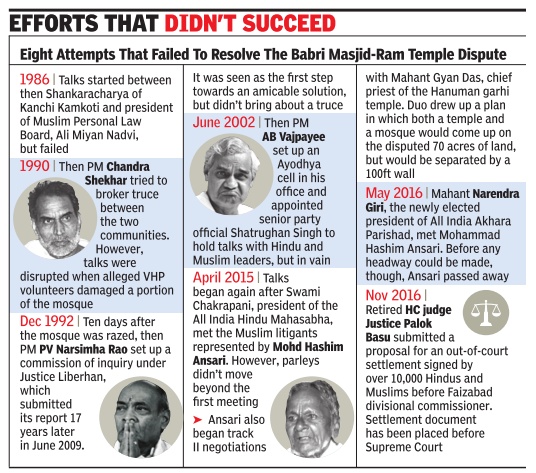

Swamy Asked To Speak To All Parties Involved
In a surprise development, the Supreme Court on Tuesday urged the opposing parties in the Ayodhya dispute to make another attempt to resolve their differences through negotiations. Chief Justice of India J S Khehar advocated a “give and take“ approach and even offered himself as a mediator.
The sensitive Ram Janmabhoomi-Babri Masjid dispute was back in the limelight just days after a BJP government headed by Aditya Nath Yogi took office in Uttar Pradesh.
The CJI said, “The parties must first sit together and hold a meeting cordially to agree to settle the sentimental issue through negotia tions. It is far better than fighting in court.“
The SC asked BJP MP Subramanian Swamy to talk to all parties and renew his request for early hearing of petitions on March 31. If the parties do not reach a consensus to restart negotiations, the judicial process is likely to proceed.
Swamy provided the trigger for a torrent of observations from a bench of Chief Justice Khehar and Justices D Y Chandrachud and Sanjay Kishan Kaul by seeking urgent hearing on appeals against the Allahabad HC's Sep tember 30, 2010 judgment which divided the disputed land into three equal parts between Sunni Wakf Board, Nirmohi Akhara and `Ram Lalla', the idol.
The SC had stayed the high court verdict on May 9, 2011 with the judges on the bench -Aftab Alam and R M Lodha -terming the decision strange as no party to the suits had claimed relief on the lines decided by the ruling. The contestants to the disputed sites clearly did not accept the HC's formulation.
When Swamy mentioned the petitions for early hea ring, the CJI said it was not difficult to list the case and decide the issue judicially . “But this is not one of those issues which can be decided in a huff.Given the sensitivity attached to the issues in question, it is best to settle the differences through negotiations between parties. All must adopt a `give a bit and take a bit' approach to find a solution to this issue,“ the CJI said.
Swamy said several attempts had been made in the past to find a negotiated settlement to the vexed issue that has been festering for nearly 70 years but the CJI said it wo uld do no harm if the parties sat together and chalked out a format for negotiation and informed the court about it.
Justice Khehar took most by surprise when he offered his service as principal mediator for negotiators chosen by parties to the dispute to facilitate talks.
“If parties want me to do the job, I will not hear this case and take up that task. If the parties want a brother judge, I am ready to provide him for facilitating the negotiation process,“ he said. This is significant, as it would be for the first time the SC has ex pressed willingness to provide a sitting judge as facilitator of negotiations between parties to find a solution to the dispute which is shrouded in competing claims, which includes the alleged placing of idols of Ram and other gods in the central dome of the disputed structure on December 23, 1949.
“If you want, the parties can choose negotiators of their choice for this purpose.These issues are best settled by sitting jointly . We can decide the issue judicially and our order will bind all parties.But such sensitive issues are best decided through negotiations by adopting a give and take policy,“ the CJI said.
Allahabad HC had taken into account pleadings by all parties as well as findings of the Archaeological Survey of India, which was tasked to identify whether the disputed structure was built on a temple by Mughal king Babur in the 16th century .
All three judges of the HC bench wrote separate judgments but the common point in the majority judgment was that the 2.7 acres of land, on which the disputed structure was located before its demolition on December 6, 1992, would be divided equally between Sunni Wakf Board, Nirmohi Akhara and the idol of `Ram Lalla', which was considered a legal entity.
Immediately after demolition of the Babri Masjid by `kar sevaks' on December 6, 1992, the central government had in 1993 persuaded Parliament to enact the Ayodhya Act to acquire the entire 67.03 acres of land around the disputed structure. The SC had ordered status quo in the 67.03 acres while allowing worship of `Ram Lalla' in a makeshift temple near the demolished structure. In its May 9, 2011 interim order, the court had reiterated the status quo.
2017: Advani, Joshi, Uma to be tried again for Babri conspiracy
Dhananjay Mahapatra & Amit Anand Choudhary, April 20, 2017: The Times of India
Proceedings To Be Wrapped Up in Two Yrs: SC
In a serious setback to BJP veterans, the Supreme Court resurrected criminal conspiracy charges against L K Advani, Murli Manohar Joshi, Uma Bharati and others in the 25-year-old Babri Masjid demolition case and set a two-year deadline for conclusion of trial.
Adopting a tough `let justice be done though the heavens fall' line in the appeal filed by the CBI in the politically sen sitive case, a bench of Justices P C Ghose and R F Nariman on Wednesday invoked the power vested in it under Article 142 of the Constitu tion to transfer the trial against the BJP functionaries from Rae Bareli to Lucknow. SC’s decision means that two trials — conspiracy charges against Sangh leaders and a case dealing with the demolition of Babri Masjid — will proceed simultaneously.
The court ordered charges to be framed in four weeks, daytoday trial and fixed a two-year deadline for the Lucknow court to pronounce judgment in both cases. It also said there would be no de novo (fresh) trial and that matters would proceed from the stage where they have reached. Frowning at frequent transfers of trial judges assigned to the case, the SC said the trial judge would not be mo ved and directed the CBI to ensure presence of witnesses.
Quashing a May 2010 order of the Allahabad HC that absolved senior BJP leaders of the criminal conspiracy charge, the bench said, “The court of sessions (in Lucknow) will frame within four weeks an additional charge under Section 120B (criminal conspiracy) against Advani, Joshi, Bharati, Vinay Katiyar, Sadhvi Rithambara, Vishnu Hari Dalmia, Champat Rai Bansal, Satish Pradhan, Dharam Das, Mahant Nritya Gopal Das, Mahamandaleshwar Jagdish Muni, Ram Bilas Vadanti, Vaikunth Lal Sharma alias Prem and Dr S C Nagar.”
Some of the accused are dead. Framing of conspiracy charge against the BJP leaders means they will be liable to face trial for offences committed by kar sevaks on December 6, 1992, when the mosque was demolis hed. The trial of Shiv Sena founder Bal Thackeray has abated after his death.
The SC said since the alleged offences committed by BJP leaders and kar sevaks were adjopart of the same intent to carry out the alleged conspiracy, trials could not have been separated, irrespective of the fact that 49 different FIRs were lodged.
“That being the case, it is clear that the said accused could not possibly have been discharged, as they were already arrayed as accused insofar as the charge of criminal conspiracy was concerned, which would be gone into by the special judge, Lucknow, while dealing with the offences made out in FIR No. 197 of 1992 (against kar sevaks),” the SC said. Writing the 40-page no frills judgment for the bench, Justice Nariman said the trial court will conclude proceedings in two years by conducting day-to-day hearing.
It imposed tough conditions for completion of trial in two years that could restrict the options of defence lawyers seeking loopholes. “The trial court will, after transfer of proceedings from Rae Bareli to Lucknow and framing of additional charges, within four weeks, take up all the matters on a day-to-day basis from the stage at which the trial proceedings, both at Rae Bareli and at Lucknow, are continuing, until conclusion of the trial,” it said.
“There shall be no de novo trial. There shall be no transfer of the judge conducting the trial until the entire trial concludes. The case shall not be adjo mourned on any ground except when the sessions court finds it impossible to carry on the trial for that particular date. In such an event, on grant of adjournment to the next day or a closely proximate date, reasons for the same shall be recorded in writing,” the bench said.
The court also put the CBI to strict terms. “The CBI shall ensure that on every date fixed for evidence, some prosecution witnesses must remain present, so that for want of witnesses the matter be not adjourned,” it said and permitted all parties before the trial court to move the SC “in the event of these directions not being carried out, both in letter and spirit”.
2018: SC rejects Muslim plea for 5-judge bench; directs early hearings
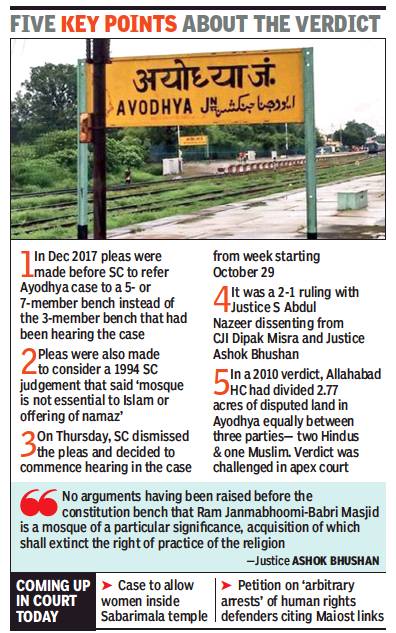
From: Dhananjay Mahapatra & Amit Anand Choudhary, SC decision paves way for early hearing of Ayodhya land row, September 28, 2018: The Times of India
The Supreme Court removed the roadblocks for early hearing of seven-year-old appeals challenging the Allahabad high court’s decision to divide the 2.77 acres of disputed land in Ayodhya equally among three parties by rejecting the pleas of Muslim parties to refer to a five-judge bench the appeals as well as a contentious remark in a 1994 SC judgment that a “mosque is not essential to Islam or offering of namaz”.
It ordered commencement of hearing on the appeals from the week beginning October 29 in what can brighten the prospect for resolution of the vexed issue of ownership of the disputed Ayodhya site next year, perhaps even before Lok Sabha elections scheduled for April-May.
During the arguments that started on December 5 last year, when the CJI-led bench was told that it would take at least one year for completion of arguments given the voluminous documents as well as other evidence, the bench had asked, “Arguments on the title suits before the Allahabad HC took only 90 days and the appeals will go on for a year?”
On Thursday, a bench of CJI Dipak Misra and Justices Ashok Bhushan and S Abdul Nazeer by 2-1 majority said, “We are of the considered opinion that no case is made out to refer the 1994 Constitution bench judgment of this court in Ismail Faruqui for reconsideration. We make it clear that questionable observations made in Faruqui’s case were made in the context of land acquisition. Those observations were neither relevant for deciding the (title) suits (in Allahabad HC) nor relevant for deciding these appeals.” However, Justice Nazeer stuck a dissenting note to the majority verdict that Justice Bhushan wrote for himself and CJI Misra.
He mentioned a three-judge bench’s order on September 24 which had referred petitions seeking a ban on the Dawoodi Bohra community’s practice of female genital mutilation to a five-judge bench and said that the Ayodhya land dispute, as well as the remark in the Faruqui judgment, raised an important constitutional question deserving reference to a larger bench. The Muslim parties had argued that a five-judge bench needed to hear the issue raised by the 1994 judgment about the essentiality of mosques to Islam before getting down to adjudicate the appeals against the Allahabad HC order.
The court turned down the argument and said an unnecessary controversy had been sought to be created by generalising the remark that “a mosque is not essential part of the practice of the religion of Islam and namaz by Muslims can be offered anywhere, even in the open”.
It said the remark was made in the context of the acquisition of the site where Babri Masjid stood, and to rebut the argument that mosques enjoyed immunity from acquisition of land by the government.
‘5-judge benches heard cases less important, so why not this one?’
Justice S Abdul Nazeer penned a dissent and said if the Supreme Court could refer petitions challenging polygamy and nikah halala, Ramleela and puja in public parks, and female genital mutilation to five-judge benches, the Ayodhya land dispute and Ismail Faruqui case remark should also be referred to a constitution bench.
“It is clear that questionable observations in Ismail Faruqui have certainly permeated the impugned (Allahabad HC) judgment. Thus, the impugned judgment can be claimed to be both expressly and inherently affected by the questionable observations made in Ismail Faruqui,” Justice Nazeer said.
“Further, Ismail Faruqui prima facie leads a different approach regarding the application of essential and/or integral test which also needs to be resolved as a matter of constitutional significance. In my view, Ismail Faruqui needs to be brought in line with the authoritative pronouncements in Shirur Mutt and other decisions,” he said in his order, diametrically opposite to the views of CJI Dipak Misra and Justice Ashok Bhushan, to refer the Ayodhya land dispute as well as Faruqui remark to a five-judge bench.
He appeared to accept the arguments of senior advocates Kapil Sibal, Rajeev Dhavan and Dushyant Dave that when less important issues were referred to constitution benches, why not give similar credence to the most important issue before the nation.
“A three-judge bench led by CJI Misra on March 26 had referred a petition by Sameena Begum and others challenging matters relating to polygamy, including nikah halala, nikah mutah and nikah misya, to a constitution bench,” Justice Nazeer said. He added that on July 6, a two-judge bench had referred a petition by Jyoti Jagran Mandal to test the validity of permission given to Ramleela and pujas once a year in public parks to a five-judge bench. He also highlighted a threeday-old decision by a threejudge bench led by CJI Misra to refer to a constitution bench a bunch of petitions led by Sunita Tiwari, which sought a ban on female genital mutilation (FGM). Justice Nazeer said, “Considering the constitutional importance of the issues (in the plea relating to Ayodhya and Ismail Faruqui judgment remark), the following need to be referred to larger bench.”
Negotiation bids
1994, 2003
Despite many an attempt for negotiated settlement on the 2.77 acre land at Ram janambhoomi-Babri Masjid disputed site going awry in the last 25 years, the SC on Tuesday decided for the first time to invoke powers under Section 89 of the Civil Procedure Code and employ courtappointed mediation process to solve the vexed issue.
Section 89 provides: “Where it appears to the court that there exist elements of a settlement which may be acceptable to the parties, the court shall formulate the terms of settlement and give them to the parties for their observations and after receiving the observations of the parties, the court may reformulate the terms of a possible settlement and refer the same for arbitration, conciliation, judicial settlement including settlement through Lok Adalat, or mediation.”
After demolition of Babri Masjid on December 6, 1992, the Centre had acquired the disputed land as well as 67 acres surrounding it through a law. When its validity was challenged in the SC, the Centre had sent a Presidential Reference asking the SC to determine whether a Hindu temple pre-existed the demolished mosque. The P V Narasimha Rao government had told the SC on September 14, 1994 that once the SC answered the Reference, it would make efforts to resolve the controversy through negotiations.
In Ismail Faruqui judgement on October 24, 1994, the SC upheld validity of acquisition of Ayodhya land but had said: “This is a matter suited essentially to resolution by negotiations which does not end in a winner or loser, while adjudication leads to that end. It is in the national interest that there is no loser at the end of the process adopted for resolution so that the final outcome does not leave behind any rancour in anyone. This can be achieved by a negotiated solution on the basis of which a decree can be obtained in terms of such solution in these suits. Unless a solution is found which leaves everyone happy, that cannot be beginning for continued harmony between ‘we the people of India’.”
There were some negotiations, as the judgement records, between VHP and All India Babri Masjid Action Committee, which broke down at a crucial phase. A significant effort for a negotiated settlement was made by Kanchi Shankaracharya in 2003. But it broke down after his July 1, 2003 letter to All India Muslim Personal Law Board stating: “Kashi, Mathura and Ayodhya - all three belong to Hindus and keeping in mind the larger interest of the country and communal harmony, if not today, but at some time or other, these places have to be given to the Hindus. The Muslims have to mentally prepare themselves for this.”
A significant effort for a negotiated settlement was made by Kanchi Shankaracharya in 2003. But it broke down after his letter to All India Muslim Personal Law Board
1994, 2003, 2017
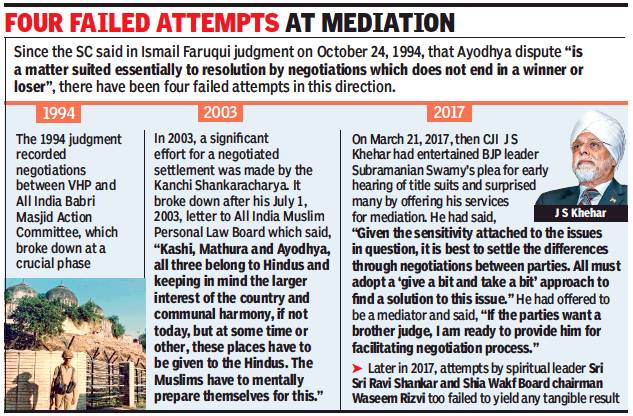
From: March 9, 2019: The Times of India
See graphic:
Attempts at mediation on Ayodhya dispute, 1994, 2003, 2017
2019: first mediation with court sanction
Subhash Mishra, Yusra Husain, March 9, 2019: The Times of India
Supreme Court’s verdict on setting up a three-member panel for mediation to resolve the contentious Ayodhya dispute, takes the clock 30 years back, when a similar exercise was initiated for the first time, but made no headway. Eight prime ministers in the past tried this route, but failed.
The only difference in drawing an outcome through mutual dialogue is that in 1990, it was inspired by the Central government and this time it has been led by Supreme Court.
A formal process of negotiation was first taken up in 1986 between then Kanchi Shankaracharya and then president of All-India Muslim Personal Law Board (AIMPLB), Maulana Abul Hasan Ali Hasani Nadwi, popularly known as Ali Miyan.
“Ali Miyan spoke to the Shankaracharya, who was ready to become a receiver in the dispute and initiate talks while the court case continued. A proposal was to be made and board members were ready for talks, but the Shankaracharya backed out and apologised for not taking up the role, citing pressure from various corners,” said convener of the Babri Masjid Action Committee ( BMAC), Zafaryab Jilani. “This mediation ordered by SC, will be the first with legal sanctity,” said Jilani.
In 1990, then prime minister VP Singh initiated the first out-of-court settlement through some officers, but before he could formalise the process he was dislodged and Chandra Shekhar succeeded him as PM.
In 1991, Chandra Shekhar kickstarted the out-of-court settlement process by deputing controversial godman Chandraswami, who held a series of meetings with both parties. Then minister of state for home Subodh Kant Sahay constituted a high-power committee comprising three chief ministers — Mulayam Singh Yadav, Sharad Pawar and Bhairon Singh Shekhawat — for the purpose. But before he could make any impact, Parliament was dissolved and fresh elections held.
In 1992, PV Narasimha Rao resumed the dialogue process. And again Chandraswami was the interlocutor. But by the time talks could mature, VHP made an appeal for kar sewa leading to the demolition of Babri Masjid, halting the out-of-court process for a long period and both parties hardened their stands further.
In 2000-02, Atal Bihari Vajpayee resumed the discussions between the two parties by formally opening an Ayodhya cell in the PMO and chaired a series of meetings between VHP and the All-India Muslim Personal Law Board. Kunal Kishore, a senior IPS officer, played the anchor role in the mediation process, but the process again proved an exercise in futility.
The AIMPLB was again approached by the new Shankaracharya of Kanchi Kamakoti Peetham in 2002-2003, who came to Lucknow’s Darul Uloom Nadwatul Ulama with a slew of proposals. Few points of the proposal were rejected by AIMPLB. While no overt moves were made during the Manmohan Singh regime, Justice (retired) Pulak Basu of the Allahabad High Court led a signature campaign in 2010, drawing a conclusion that the mediation process should be left to local people of Ayodhya.
1994-2019: Four failed mediation attempts
Dhananjay Mahapatra, August 2, 2019: The Times of India
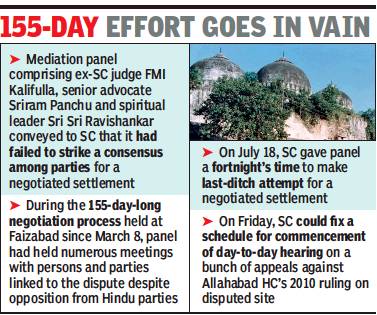
From: Dhananjay Mahapatra, August 2, 2019: The Times of India
Any glimmer of hope for a negotiated settlement to the long-pending dispute over the ownership of the 2.77-acre Babri Masjid-Ram Janmabhoomi land in Ayodhya faded with the Supreme Court-appointed highlevel mediation panel on Thursday expressing its inability to resolve the issue.
A bench of CJI Ranjan Gogoi and Justices S A Bobde, D Y Chandrachud, Ashok Bhushan and S Abdul Nazir will take up the matter on Friday and could fix a schedule for commencement of day-to-day hearing on a bunch of appeals challenging the Allahabad high court’s September 30, 2010 verdict which divided the disputed land into three equal parts — one part each to Ram Lalla (idol), Nirmohi Akhara and Sunni Waqf Board.
The mediation panel, comprising former SC judge FMI Kalifulla, well-known mediator and senior advocate Sriram Panchu and spiritual leader Sri Sri Ravishankar, which was given a fortnight on July 18 by the SC to make a last-ditch attempt for a negotiated settlement, conveyed that they had failed to strike a consensus among rival parties and it was time to wind up the mediation process.
During the 155-day-long negotiation process held in Faizabad since March 8, the panel held numerous meetings with various people and parties connected to the dispute despite steadfast opposition from Hindu parties, who have filed appeals in the SC. The Muslim parties had said in the SC that they supported a negotiated settlement.
The panel, sources said, detailed its earnest efforts to bring the rival parties together and its success in getting moderates on both sides to agree to sit across the table to negotiate a solution. However, the panel said it failed to convince the hardliners on both sides to do the same.
Four mediation attempts have failed since 1994
On July 18, the five-judge bench led by CJI Gogoi had asked the panel to submit a status report on the negotiation process and indicated that, if required, it would pass orders for the schedule for commencement of hearing on the appeals pending in the SC for the last nine years.
The panel had on July 18 conveyed to the SC that it hoped to bring extreme elements on both sides to the negotiating table.
The Allahabad HC had decided the title suits and divided the core disputed land into three equal parts. All three awardees and others challenged the HC verdict, saying it was not the prayer of any of the parties for a three-way division of the disputed land.
Ever since the SC said in the Ismail Faruqui judgment on October 24, 1994 that the Ayodhya land dispute “is a matter suited essentially to resolution by negotiations which does not end in a winner or loser”, there have been four failed attempts in this direction.
Ownership of the land, undisputed and disputed
How VHP got to own 43 acres
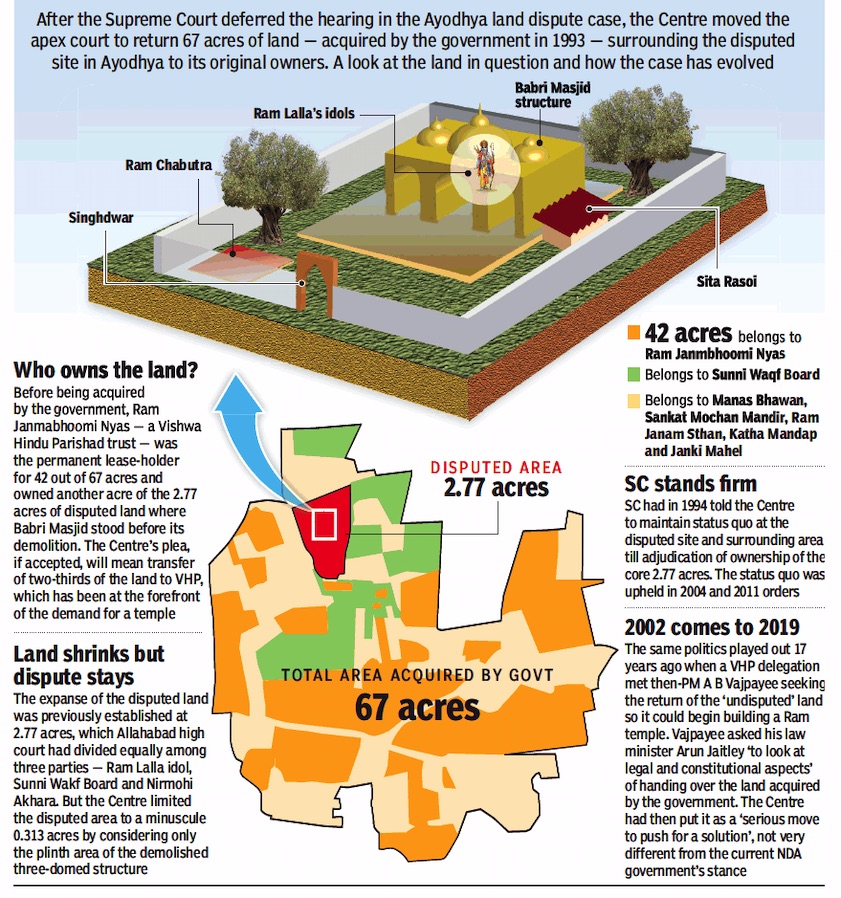
From: January 31, 2019: The Times of India
See graphic:
VHP’s 43 acres of undisputed land in Ayodhya
Nirmohi Akhara’s stand: 1993-2019 April
Dhananjay Mahapatra, Nirmohi opposes govt plea on Ayodhya land, April 10, 2019: The Times of India
Nirmohi Akhara, which along with Ram Lalla and Sunni Wakf Board was given one-third of the 2.77-acre core disputed land in Ayodhya by the Allahabad high court, moved the Supreme Court on Tuesday opposing the Centre’s surprise move for return of the surplus 67 acres to its original owners.
On January 28, the Centre had filed an application in the Supreme Court seeking return of 67 acres of surplus land, except the 2.77-acre disputed Ram Janmabhoomi-Babri Masjid land to its original owners, including Ram Janmabhoomi Nyas, which owns 42 acres.
Akhara diverged from other Hindu claimants earlier also
The land in question was acquired by the Union government through the ‘Acquisition of Certain Areas at Ayodhya Ordinance’ on January 7, 1993, in the wake of the demolition of Babri Masjid in what was seen as an attempt to preempt any construction by the Nyas in the immediate vicinity of the disputed site. The ordinance was later replaced by an Act bearing the same nomenclature.
Opposing the Centre’s application, Nirmohi Akhara said it was the owner of Sumitra Bhawan and the adjacent land, Sita Koop, Sita Koop Mandir, Dwaraka Das Mandir, Saligram Bhagwan temple and Lomas temple, all of which were demolished by the state government after acquisition of the surplus 67 acres in 1993. It said which party is entitled to what part of the disputed area would be known only when the title suit was decided. Proper utilisation of the surplus land for amenities like approach road and pilgrim facilities could be worked out only once that stage was crossed, it added. “At present, it is not known who will be the ultimate successful party and, therefore, it cannot at present be assessed what the extent of superfluous area will be,” it said. It is not the first time that Nirmohi Akhara has diverged from the stand of other Hindu claimants to the disputed site.
During hearing of the appeals against the Allahabad HC judgment dividing the core disputed land into three equal parts, the SC had suggested mediation as an alternative mechanism to resolve the 70-year-old litigation.
2019, March: Sunni board was ready to give up claim
Subhash Mishra, Nov 11, 2019: The Times of India
The Sunni Central Waqf Board, which was a key litigant in the Ayodhya title suit, had offered a settlement formula to resolve the issue in its letter to Supreme Court in March 2019, stating it was ready to relinquish its claim over the disputed site in larger interest of national harmony in lieu of a mosque at an alternative site. TOI is in possession of a copy of the settlement offer, which was sent to the Supreme Court after the mediation process was initiated by the court-appointed Justice Kalifulla-led mediation panel.
TOI had reported on October 17 that the panel had informed the SC that the Muslim parties were willing to give up their claim on the disputed site if some conditions were met, including construction of a mosque at an alternative site.
Para 5 of the Sunni Central Waqf Board’s settlement offer states, “Sunni Waqf Board, first and main plaintiff, has no objection in relinquishing all rights, interests and claims over the land and is entering into this settlement in larger interest of harmony. The board confirms there’s no bar on acquisition of the land by the central government under Section 51 (1-A of Waqf Act, 1995, or any other law). The board may build a mosque at another suitable place, keeping in view requirements of local Muslims.”
Para 14 clearly says, “The court may also consider using the settlement as the foundation for its order and decree under Article 142 of Constitution and do justice by bringing a comprehensive, effective and harmonious end to the dispute.” For relinquishing its claim, the Sunni Waqf Board put riders, including allowing namaz at ASI-controlled mosques. “In view of the extraordinary initiative by parties in national interest and in special circumstances of this case, parties plead to this court to exercise powers to direct ASI to permit regular namaz at select mosques under ASI control in Ayodhya. And for this, a committee of experts be formed to work out the modalities,” the letter stated.
It also requested security by the Centre for office-bearers of Sunni Waqf Board, other parties and their advocates.
The Babri demolition case
Delays, then fast tracking:1992-2020
Ashish Tripathi, October 1, 2020: The Times of India
Special judge SK Yadav on Wednesday took just five minutes for acquittal of 32 accused in the Babri Masjid demolition case which had seen 28 years of legal journey. And, had the Supreme Court not played an active role, it could have continued for several more years.
The SC on April 19, 2017, reignited and fast-tracked the case that was dragging on for a quarter of a century in the labyrinth of legalities.
Apart from setting a deadline for completion of the trial, the SC not only clubbed the two cases related to the same act by using extraordinary powers granted to it under Article 142 of the Constitution, but also revived conspiracy charge against LK Advani and restored trial of 13 others saffron stalwarts against whom CBI had dropped all charges about a decade ago.
The seeds of delay were sowed by the Congress government led by PV Narasimha Rao that indirectly ruled the state after imposition of President’s rule. About 49 cases were lodged by the police on December 6, 1992. However, instead of allotting all the cases to one agency, the state government gave the kar sewak (197) case to CBI, state’s CB-CID was asked to probe the speech case (198). A special court in Lalitpur was created for trial which was later shifted to Rae Bareli on July 8, 1993.
Eight months after the incident, UP government realised that all the cases should be probed by one agency and entrusted CBI with the job on August 26, 1993. However, within 15 days, another complication was introduced when the government created a special court in Lucknow for trial of kar sewak case, while speech case remained in Rae Bareli court.
2019/ Babri Demolition Case, ruling
1
2
SC veered towards unanimity after hearings ended
Dhananjay Mahapatra, Nov 11, 2019: The Times of India
The five-judge constitution bench of the Supreme Court veered towards a unanimous decision on the Ayodhya dispute soon after the arguments concluded on October 16, though each judge had been meticulously taking down notes and preparing to write a judgment on his own from the day the hearings began on August 6.
Once the unanimity of view was achieved, one of the judges was entrusted the task of writing the judgment. The first draft was ready late on November 3 and was circulated among the judges the next day. The judges exchanged their views, suggested additions and deletions as well as alterations in the final draft. The final judgment was ready for pronouncement.
The Supreme Court bench decided to announce the verdict on Saturday after the five judges learned first-hand from police officials as well as from the Union home secretary and Intelligence Bureau chief that adequate security arrangements had been put in place to deal with possible law and order disruptions as well as angry response from some quarters.
Judges decided to use element of surprise
CJI Ranjan Gogoi, CJIdesignate SA Bobde and Justices DY Chandrachud, Ashok Bhushan and S Abdul Nazeer sought to know from Union home secretary A K Bhalla and Intelligence Bureau chief Arvind Kumar about the situation on the ground across the country and, especially, if there was a possibility of trouble from either of the two communities locked in the fight for the Ayodhya site.
While the intelligence chief said there was no threat of any trouble, the home secretary briefed them about adequate security arrangements being made by the Centre and states to prevent any untoward incident. After meeting the Intelligence Bureau chief and home secretary, the CJI and other judges also called Uttar Pradesh’s chief secretary and DGP to understand whether there was possibility of a trouble after the judgment.
Both assured judges that there was no apprehension of any law and order situation. Reassured by the feedback from the ground, the CJI and other judges decided to use the element of surprise and pronounce the verdict.
The first draft of the unanimous judgment was ready late on November 3 and it was circulated among the judges the next day. The judges exchanged their views, suggested additions and deletions as well as alterations in the final draft by Wednesday. And by Thursday, the final judgment was ready for pronouncement. But preparation for writing the judgment was undertaken by each of the five judges right from the day the hearing began on August 6.
Evidence reinforced faith-tradition: SC
Nov 12, 2019: The Times of India
The presence of symbols of Hindu religious significance inside and outside the Babri Masjid, which were acknowledged by Muslim witnesses, suggested actual worship took place down the centuries and large congregations visited the disputed site during festivals, the Supreme Court has said.
The SC’s observations in its verdict on the Ayodhya case, bolster the argument that the Hindu community persisted with its claim to worship and the evidences gathered by the Archaeological Survey of India pointed to a religious structure of Hindu origin.
“The oral testimony of Hindu devotees establishes the pattern of worship and prayer at Sita Rasoi, Ramchabutra and towards the ‘garb grih’, while standing at the railing of the structure of the brick wall,” the court has said. The argument that the Ayodhya site’s significance went beyond faith alone, is important even as the court held that the ASI report could not be used to settle a title suit.
The judgement evaluates faith-tradition, ASI evidences, traveller accounts and witnesses to state that the presence of a masjid did not deter Hindus from continuing their worship at the disputed site and within the precincts of the structure prior to the incidents of 1856-57 (when riots broke out over access to the plot).
“The physical structure of an Islamic mosque did not shake the faith and belief of Hindus that Lord Ram was born at the disputed site. On the other hand, learned counsel fairly stated that the evidence relied on by the Sunni Wakf Board to establish the offering of namaz by the Muslim residents commences from around 1856-57,” the SC ruled.
The accounts mentioned by the court have often been part of BJP’s political campaign where the party has argued that the site is of much more significance to the Hindus than a mosque at Ayodhya was to Muslims. Records of travellers indicate, said the court, that there was “historical presence of worshippers and the existence of worship at the disputed site even prior to the annexation of Oudh by the British and the construction of a brick-grill wall in 1857.” The wall was built by the British colonial administration to separate the inner and outer courtyards and restrict access of Hindu devotees.
While the ruling notes that the ASI report does not conclude that remnants of the preexisting structure were used for the purpose of constructing the mosque or there was an act of razing, it notes a reasonable inference can be drawn that foundations of the mosque is based on the walls of a pre-existing structure. This underlying structure was suggestive of Hindu religious origin.
2020: All accused acquitted
Ravi Singh Sisodiya, Neha Lalchandani & Arvind Chauhan, October 1, 2020: The Times of India
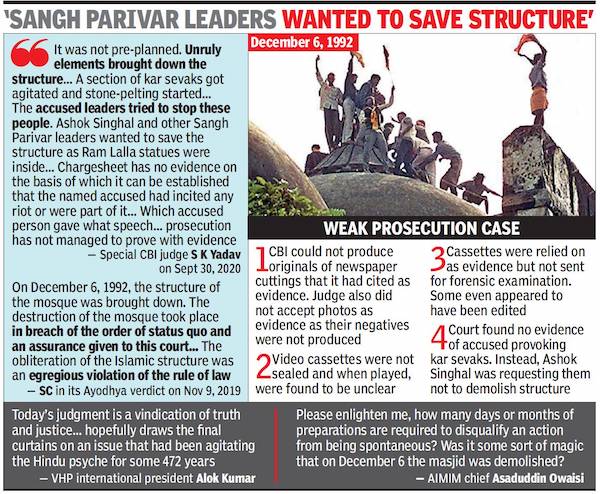
From: Ravi Singh Sisodiya, Neha Lalchandani & Arvind Chauhan, October 1, 2020: The Times of India
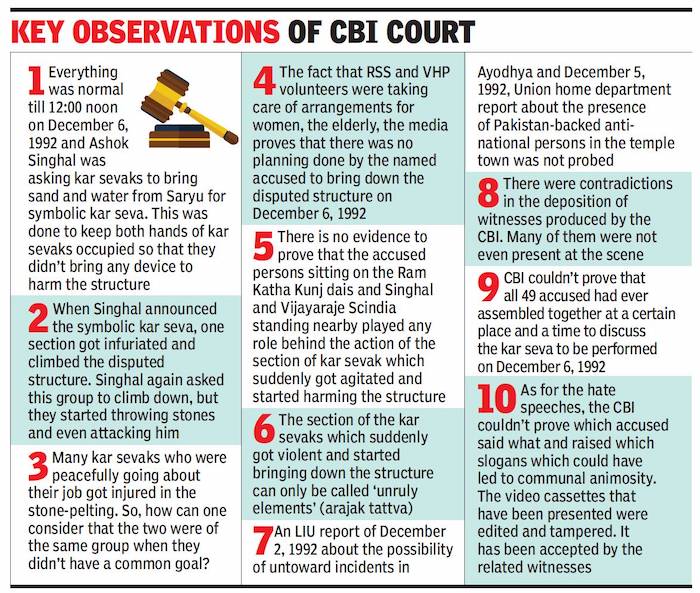
From: Ravi Singh Sisodiya, Neha Lalchandani & Arvind Chauhan, October 1, 2020: The Times of India
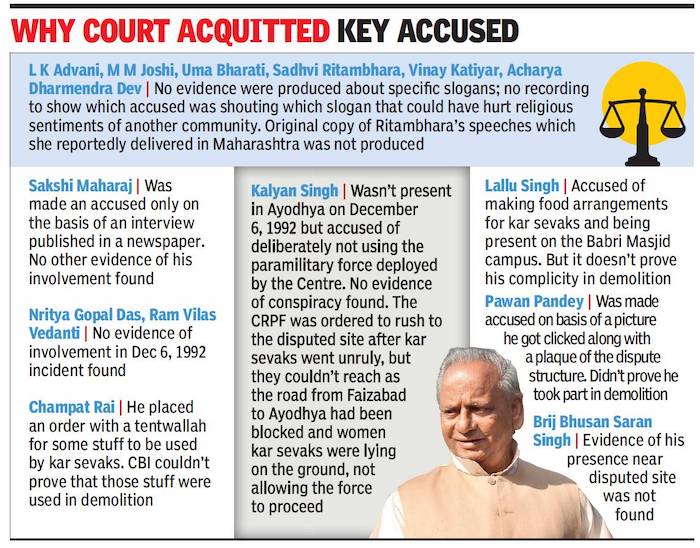
From: Arshad Afzaal Khan, October 1, 2020: The Times of India
A special CBI court acquitted all 32 accused in the Babri Masjid demolition case, giving major relief to saffron stalwarts like former deputy PM L K Advani, former UP CM Kalyan Singh, former Union minister M M Joshi, former MP CM Uma Bharti, Bajrang Dal founder Vinay Katiyar and three BJP MPs — Brij Bhushan Sharan Singh, Lallu Singh and Sakshi Maharaj.
In his order running into 2,300 pages, the judge, Surendra Kumar Yadav, said the demolition was not pre-planned and was the handiwork of “arajak tattva (unruly element )” among the kar sevaks.
Also, the CBI couldn’t prove that the accused Sangh Parivar functionaries were behind any conspiracy to demolish the 16th-century structure on December 6, 1992.
He said the CBI could not produce any conclusive evidence against any accused. “Even VHP leader late Ashok Singhal was trying to stop kar sevaks from demolishing the disputed structure because the idol of Lord Ram was also inside the structure,” the judge wrote in the verdict, delivered on the last day of his tenure. The court also accepted the defence's plea that Ram Lalla’s idols were not removed from the mandir-masjid complex and it was left to the priest, Satyendra Das, to take those out at the last moment, showing that the accused had no plans to demolish the structure.
Judge became UP dy lokayukta/ 2021
April 13, 2021: The Times of India
Former special CBI judge Surendra Kumar Yadav, who gave the verdict in the 1992 Babri demolition case acquitting all 32 accused, including LK Advani, MM Joshi, Uma Bharti and Kalyan Singh, was appointed deputy lokayukta of UP. Yadav had retired as district & sessions judge, Lucknow, in September 2019. The SC had given him an extension to deliver the verdict in the case that he had been hearing since 2015.
